
"Every designer’s dream is to have their own showroom.” A new studio for furniture line Haus of Hommeboys opens in Sonoma.
The post Award-Winning Sonoma Interior Design Firm Hommeboys Open New Studio appeared first on Sonoma Magazine.
]]>
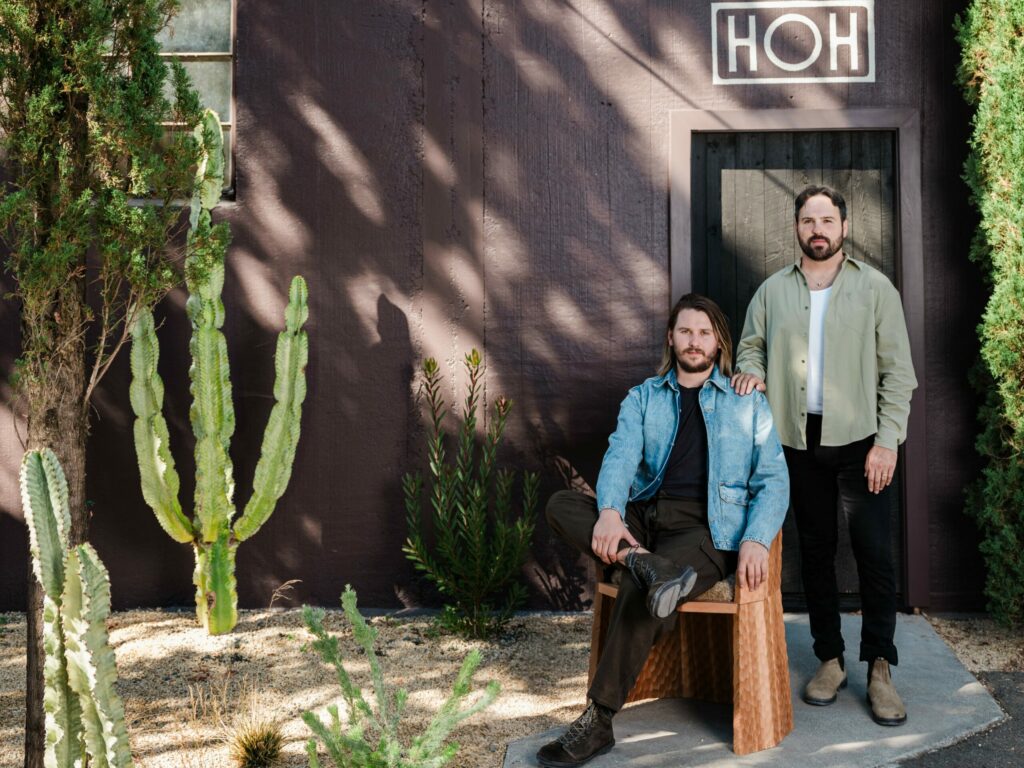
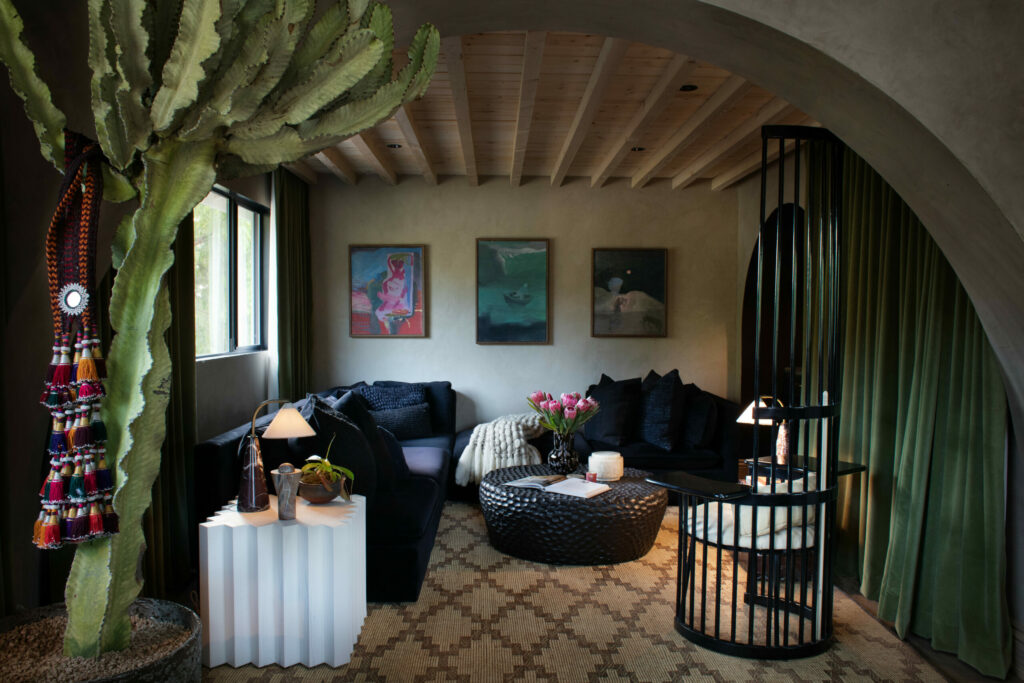
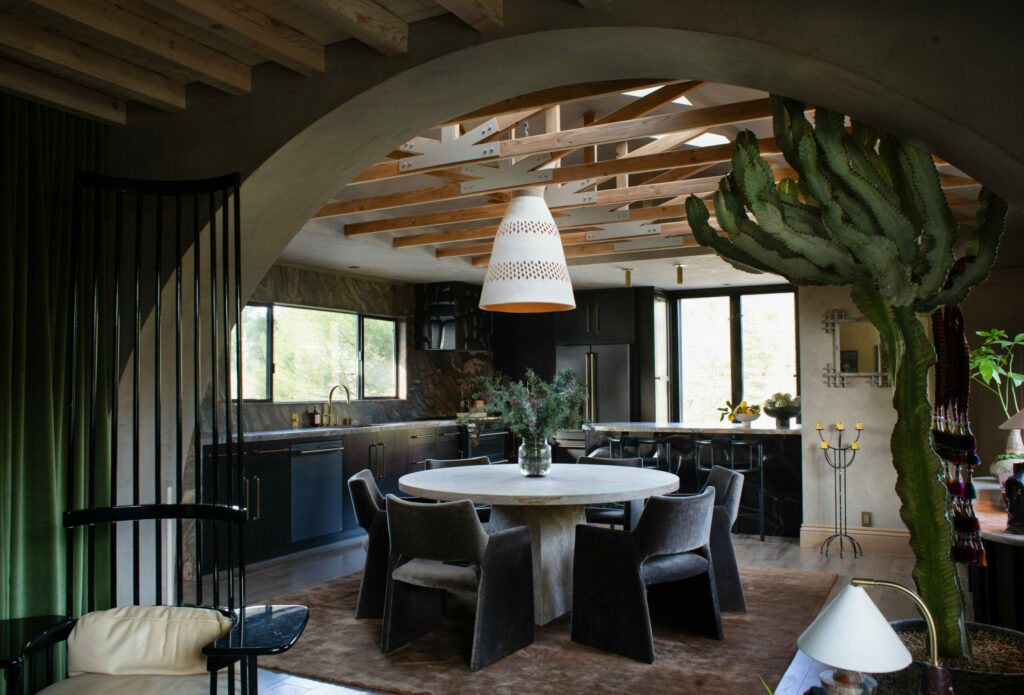
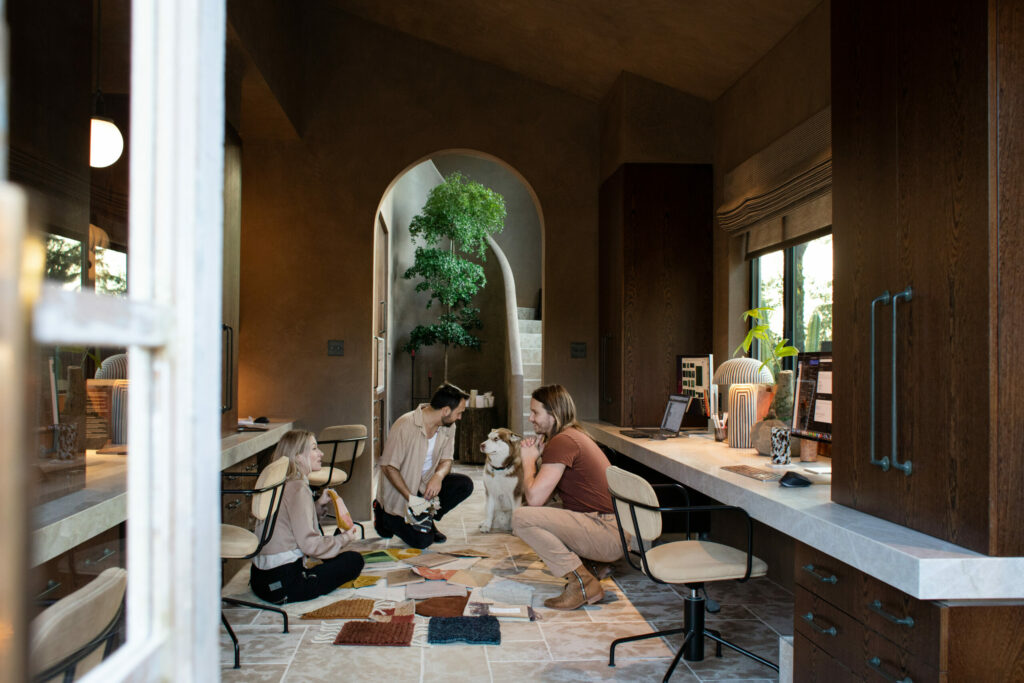
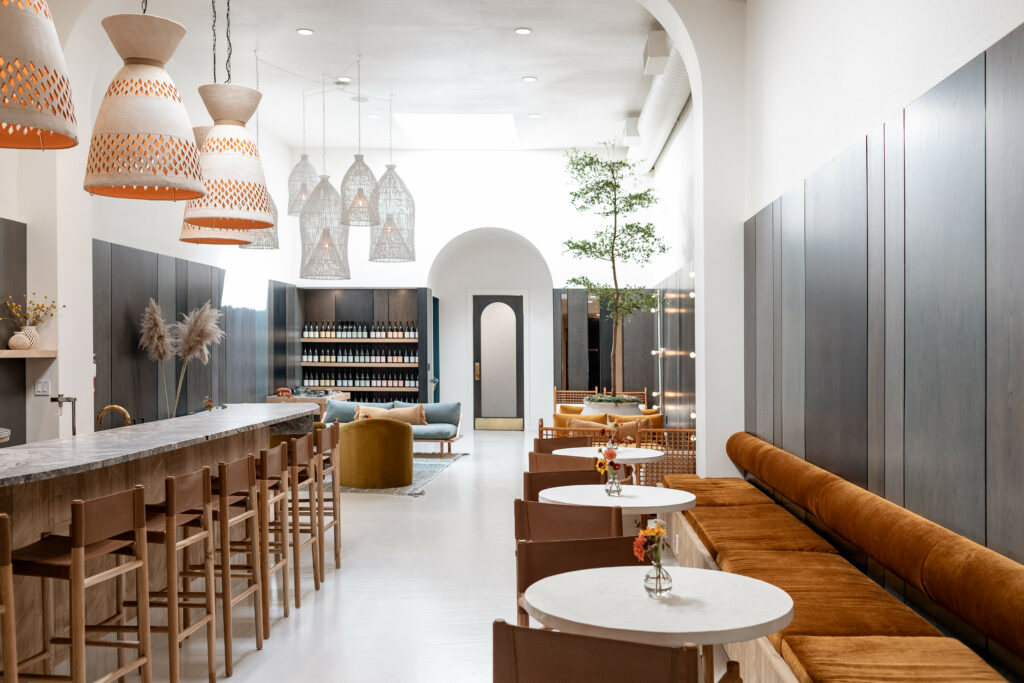
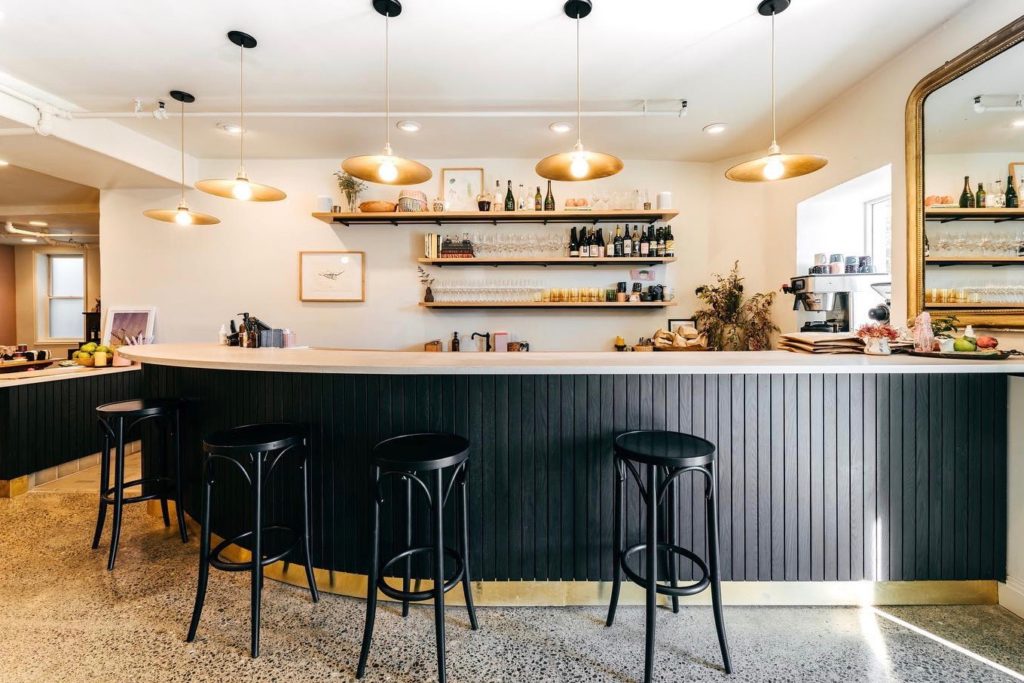
The boutique Sonoma interiors firm headed by Alex Mutter-Rottmayer and Austin Carrier marries thoughtful design with hands-on craftsmanship (see their richly detailed home in the March/April 2023 issue). Married since 2019, the two say they appreciate classic Wine Country design but think that the look is ready for a shake-up — a revolution they’ve pioneered in award-winning designs for Healdsburg’s Marine Layer tasting room and Sonoma’s Valley Bar + Bottle restaurant.
The couple are now launching three new capsule collections for their furniture line, Haus of Hommeboys, and opening a new woodshop and cabinetry studio just off the plaza in downtown Sonoma.
“It’s kind of scary,” admits Mutter-Rottmayer. “Doing all this work to see if anyone will actually like it. But we’ve always wanted to have a store. Every designer’s dream is to have their own showroom.”
Haus of Hommeboys, 141 Church St., Sonoma. hausofhommeboys.com

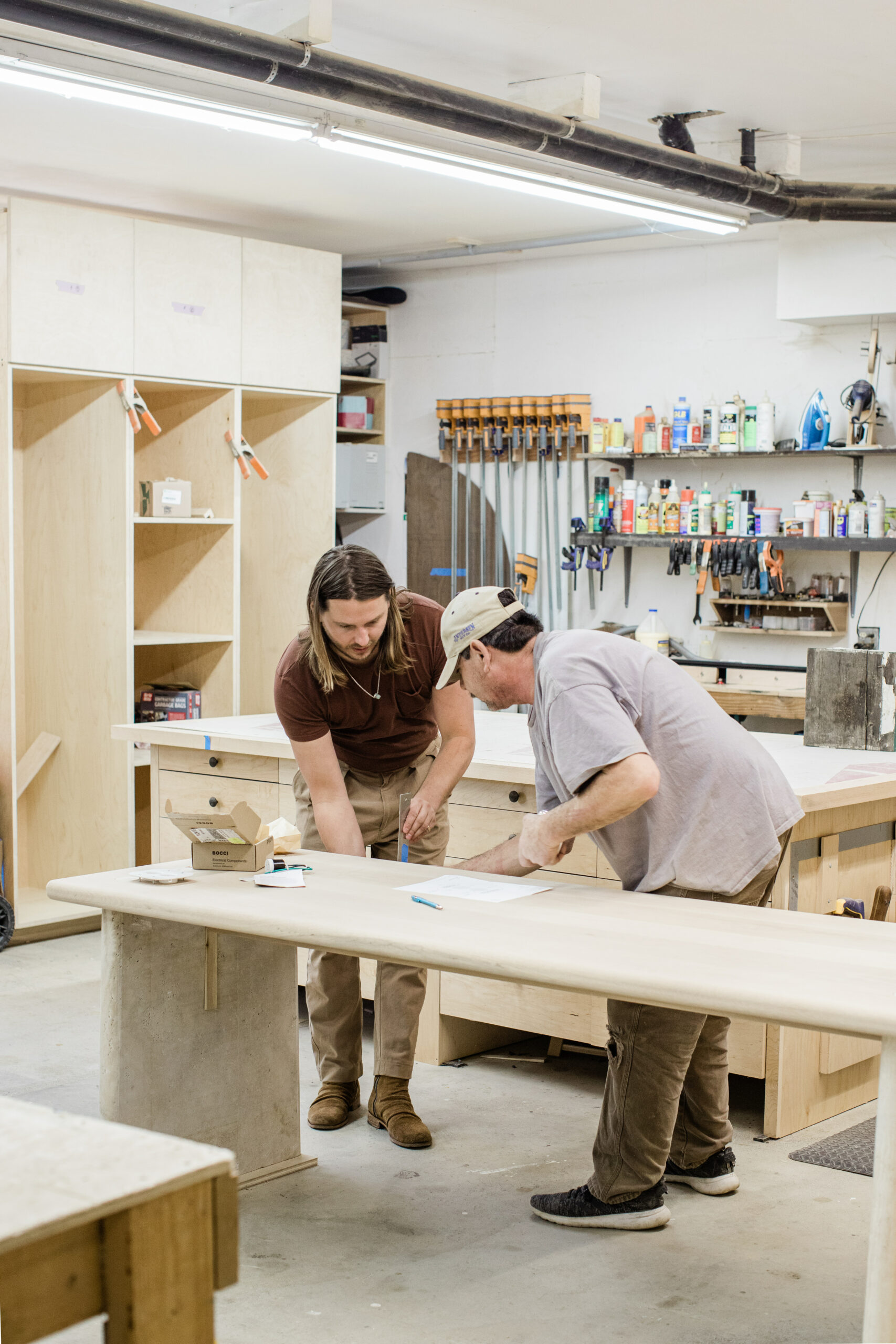
Mixing materials
Alex: “Design is in our blood. It’s what drew Austin and I together. We are always trying to mix the materials we are using, playing with different shapes in plaster, stone, wood. We definitely focus on more organic and natural materials. It’s what we are drawn to. It’s synonymous with California and this part of this country, and this gets routed back to our furniture line, which is very organic and earthy.”
Rustic inspiration
Austin: “We’ve been playing with wood for years. One of the capsule collections is dark, ebony stained, hand-notched cedar furniture. We wanted it to feel raw, rustic and edgy. The shapes are very anthropomorphized, inspired by the backdrop of California’s golden hills.”
On shaping design
Alex: “What’s the process? You just do it! One of the bedrooms we are designing had all of this green velvet from a photo shoot we were doing. And we were like, what if we just cover the walls in green velvet? What can you do with what you have? A lot of design inspiration and process comes from a desire to have fun with it.”
The post Award-Winning Sonoma Interior Design Firm Hommeboys Open New Studio appeared first on Sonoma Magazine.
]]>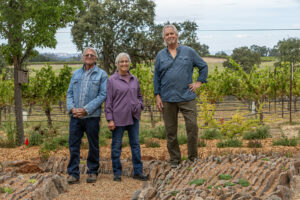
The Santa Rosa labyrinth garden’s long road to realization reinforces its call to contemplation, meditation and patience.
The post ‘I’m Here for a Reason’: A Santa Rosa Couple Replaces Their Lawn With Something More Purposeful appeared first on Sonoma Magazine.
]]>






Perri Haughwout’s decision to build a labyrinth in her front yard wasn’t rushed. She had been thinking about it for years, much like one walks a labyrinth: deliberately but slowly, in quiet consideration, allowing things to unfold.
Haughwout would look out on her front lawn with distaste, imagining something more thoughtful in its place. In time, she let the weed-stricken lawn die entirely. Then two long years passed. By chance, in October 2023 she struck up a conversation with a local acquaintance named Tim Farley, who had been designing and planting gardens for a quarter of a century — but had never built a labyrinth. Both were now excited about the project, though still not hurried.
It took another year to design and build and plant. Finally, there it was: A meandering path that embodies its own circuitous road to existence. To Haughwout, a winemaker and beekeeper, and her husband Carmen Castaldi, who recently retired as president of Healdsburg’s Rodney Strong Vineyards, the garden’s long road to realization reinforces its call to contemplation, meditation and patience.
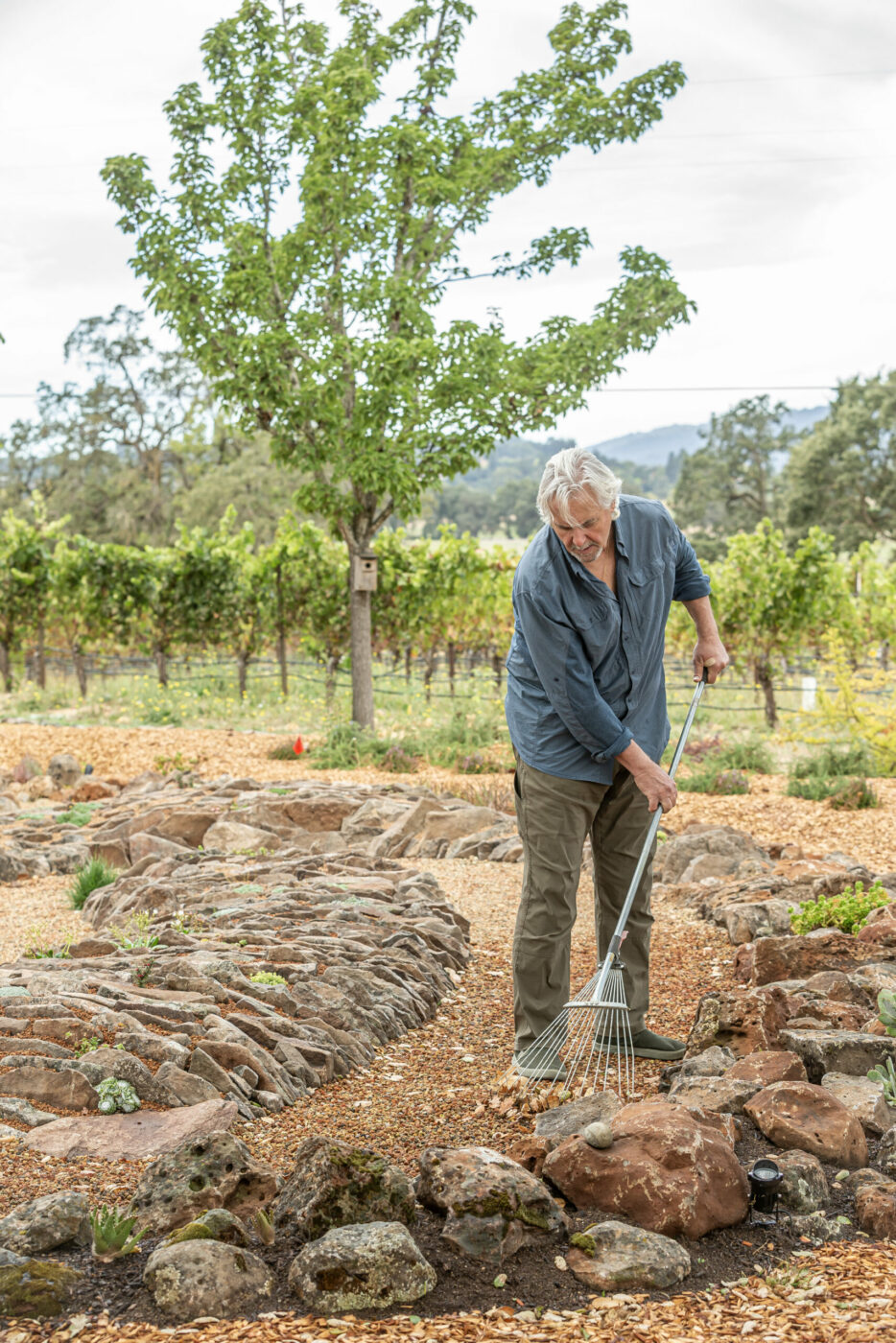
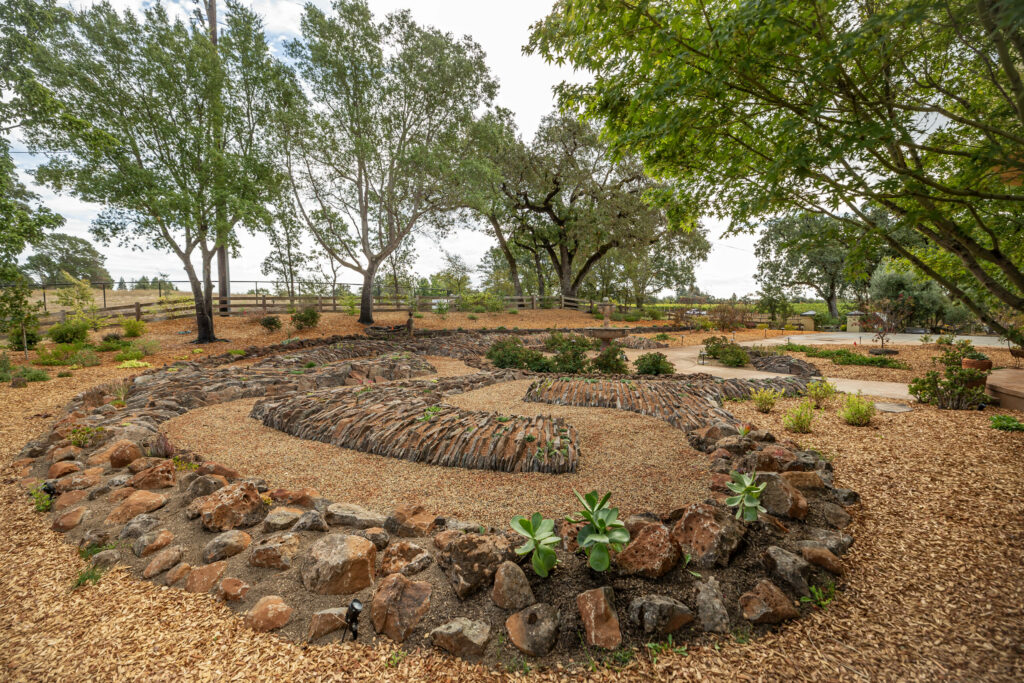
A labyrinth represents a way of looking both inward and outward, explains Haughwout, a way of bringing everything together, especially the natural world. One local example that spoke to the couple and helped set the project in motion is a grassy spiral on the Sonoma Coast along the Kortum Trail, near Shell Beach. It’s believed to have been there for over 20 years.
“People are just planting all their intentions there, and memories of people, and personal statements,” Castaldi says. “Little rocks, too. It’s very cool.”
Haughwout was immediately drawn to labyrinths as a personal tool. “I’m not one to sit still, so a way for me to center myself and focus has been walking meditation,” she says. “The walking, the purposeful walking, was what really attracted me to have this at my own house. I mentioned to my neighbors, ‘If you see me walking around in circles, you’ll know I’m just meditating, and not that crazy old lady next door, right?’”
The couple’s new labyrinth is not, in fact, a true circle. Instead, it meanders left and right, winding its way around an existing concrete path that leads to the front door. And this serpentine footprint is artfully echoed in the design of the low, mounded “walls” that define it. Farley chose to construct them of flat, slate-like slabs of locally quarried Sonoma fieldstone. The stones are placed vertically into the earth and aligned perpendicular to the flow of the lava-rock path, so each stone points to the center of the labyrinth.
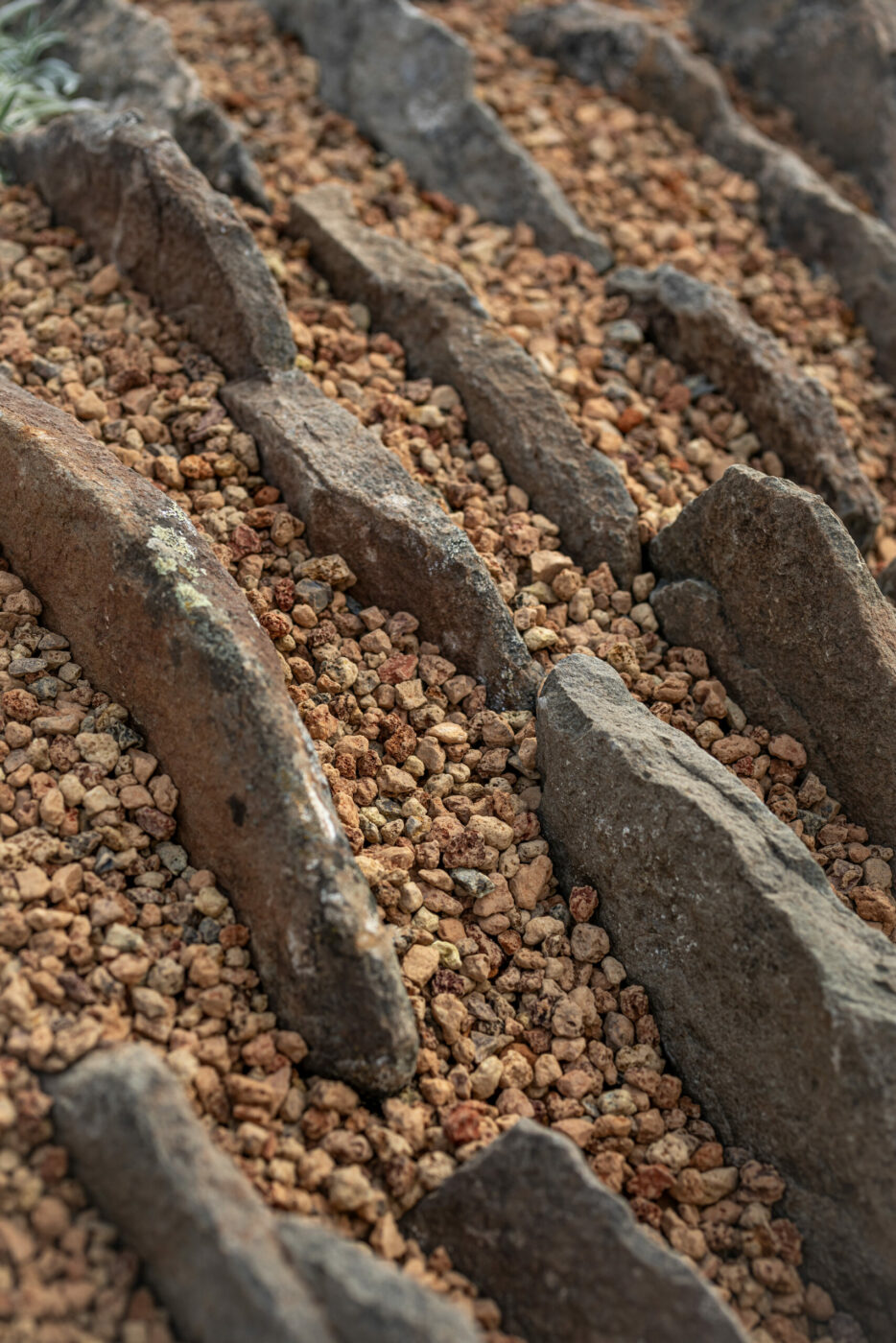
The effect is something lifelike and familiar, yet mythical. In the spaces between the stones, Farley has planted a crevice garden that Haughwout and Castaldi figure will be a perennial work-in-progress, where succulents and groundcovers and other small plants can put down roots and send up flowers and spread over the rock, softening the already gentle walls while bearing the promise of constant change.
“It’s really going to grow,” Castaldi says. “What I like is that I continue to walk around it, and every time, there’s something else there. We just started placing different nuggets that we’ve collected over the years, like a shell from the beach” — or a rock from Sedona, Haughwout adds.
Another metaphorical layer is Farley’s own labor. He estimates he spent 160 hours last winter, five or six hours at a time, often on hands and knees, selecting and hammering each stone into place.
“In the garden, a lot of times we have tasks that are repetitive,” Farley says. “It’s all about the planning. Get the stone here, get the dirt here. Once I have all that in place, and I actually go into execution, it’s very repetitive. It doesn’t take 100% of your mind state — it absolutely has some of those meditative qualities.”
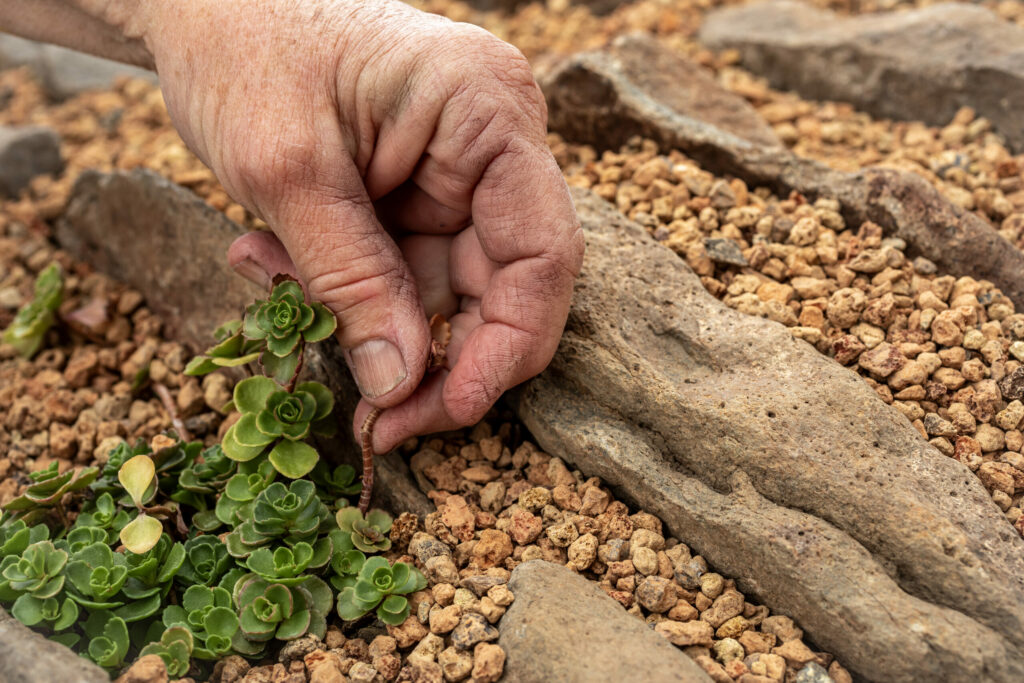
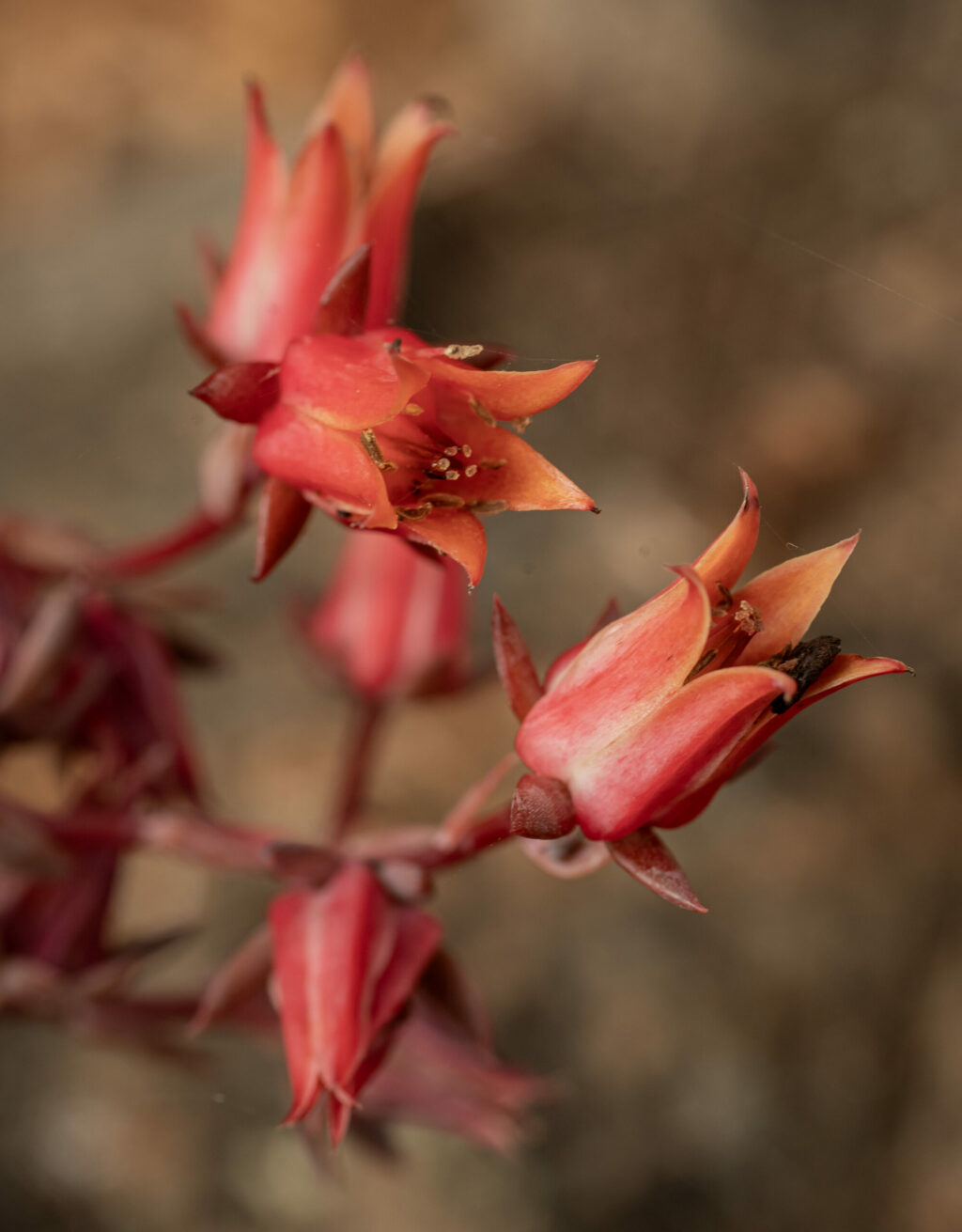
The labyrinth is adjacent to a Pinot Noir vineyard that supports Haughwout’s small label, Perri Jaye Vineyards, which produces about 150 cases of Pinot Noir and rosé each year. Once or twice a year, she invites a few dozen members of her wine club to her vineyard for an intimate gathering, with home cooking from Castaldi — and now a chance to walk the labyrinth and perhaps tuck their own small mementos into the stones.
Even as she asks guests and loved ones to bring their own remembrances, Haughwout feels a strong connection to the labyrinth.
“Walking is my way to meditate, and the labyrinth is pretty magical,” she says. “I feel like as soon as you walk in there, you just kind of go, ‘I’m here for a reason.’ And the reason is, you know, being here, being present and walking with intention.”
Resources
Landscape Design and Installation
Tim Farley
773-456-3813
unlo.com/gardens
The post ‘I’m Here for a Reason’: A Santa Rosa Couple Replaces Their Lawn With Something More Purposeful appeared first on Sonoma Magazine.
]]>
It's easy to miss this overlooked town in Mendocino County. But it has a lot to share with those curious enough to explore.
The post The Hidden Town of Hopland Is Eager To Share Its Treasures With Visitors appeared first on Sonoma Magazine.
]]>






If roads and scenery have a way of evoking moods, then there’s definitely a barometric change in tone as you head north on Highway 101 beyond Healdsburg and Cloverdale. Winding curves grow sharper as surrounding hills run up to the edge of the road. Signs advertise fossils, crystals and unusual rocks. Not long after crossing into Mendocino County on a steel truss bridge over the Russian River, the road narrows to two lanes and you roll into Hopland — a town that treasures its past and is eager to share it with curious visitors.
The perfect example is the Thatcher Hotel. Almost foreboding in its charcoal and gray facade, the gorgeously renovated 1890s Victorian opens into a warm, spacious lobby framed by an original marble-topped bar pouring holiday drinks like pumpkin spice White Russians and pear bourbon old fashioneds. A Christmas tree towers over the stately library room (yes, Jack London’s “Call of the Wild” is on the shelf).
Behind the hotel, a popular train depot once flourished, where brakemen would make jokes about “hopping off in Hopland.” Named after the bitter flowers that flavor beer, Hopland once drew hundreds of seasonal workers for the annual hop harvest, later shipping its prized bounty to brewers around the world.
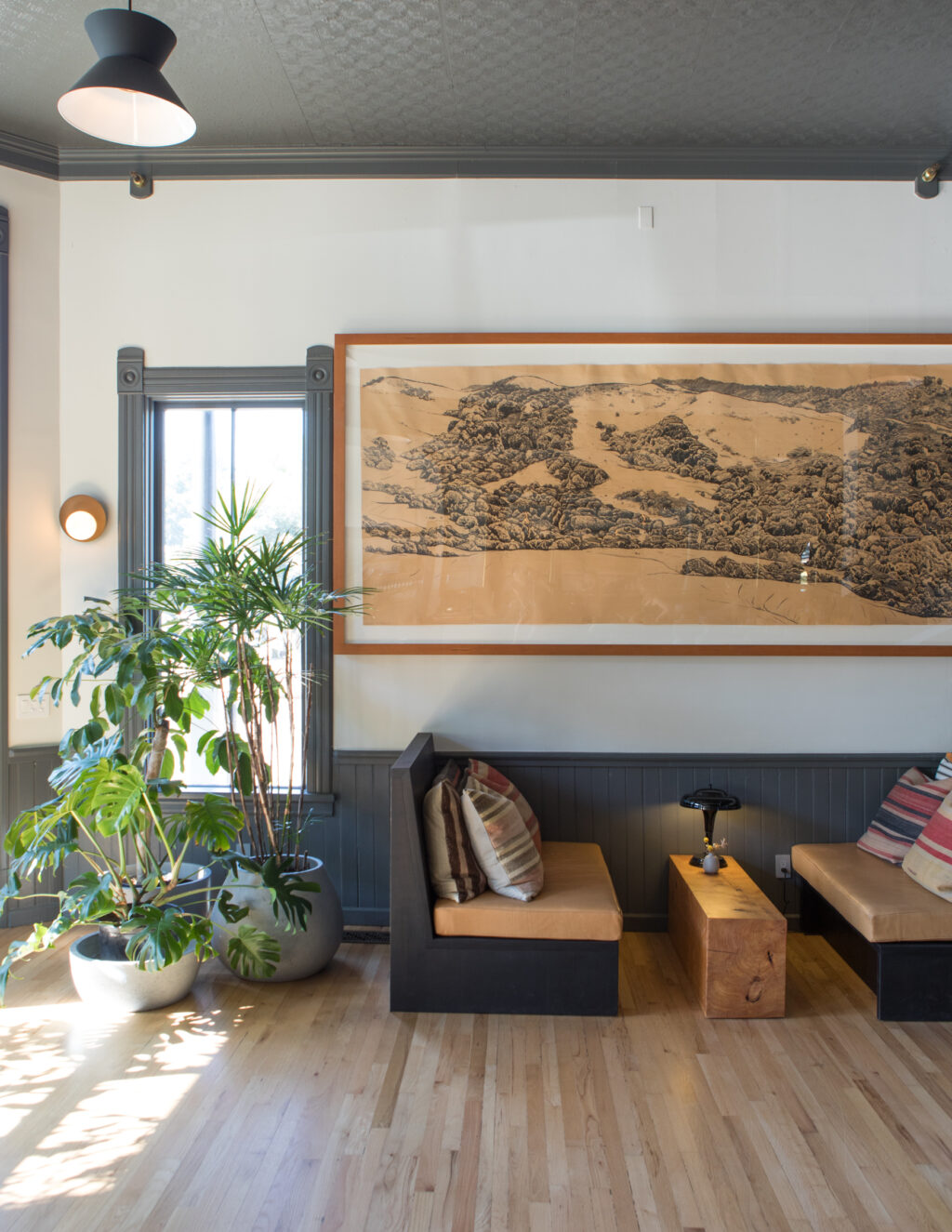
Today, the hops are gone. But that hasn’t stopped Thatcher owner Gary Breen from buying the recipe to defunct Mendocino Brewing Company’s popular Red Tail Ale. Thanks to an onsite nano-brewery, Red Tail is still always on tap at the bar.
Grapes are thriving in the region these days. From giant Bonterra (formerly Fetzer) to smaller destinations like Campovida, Alta Orsa and Blue Quail, the name of the game is organic, regenerative farming. Family-owned tasting rooms embrace the season, with a gingerbread house contest at Graziano, McNab Ridge and Brutocao wineries. Located in a former high school, Brutocao is also a good setting for a bocce ball game, weather permitting.
A trip to The Golden Pig for dinner is a must. Owner Julie Golden runs the restaurant, which goes through four to six hogs and one steer a month, sourcing from local farms including her own 2,000-acre Heart Arrow Ranch. Golden also offers tastings of Coro, a prized local cooperative wine blend of Zinfandel and Mediterranean varietals, all sourced from Mendocino County.
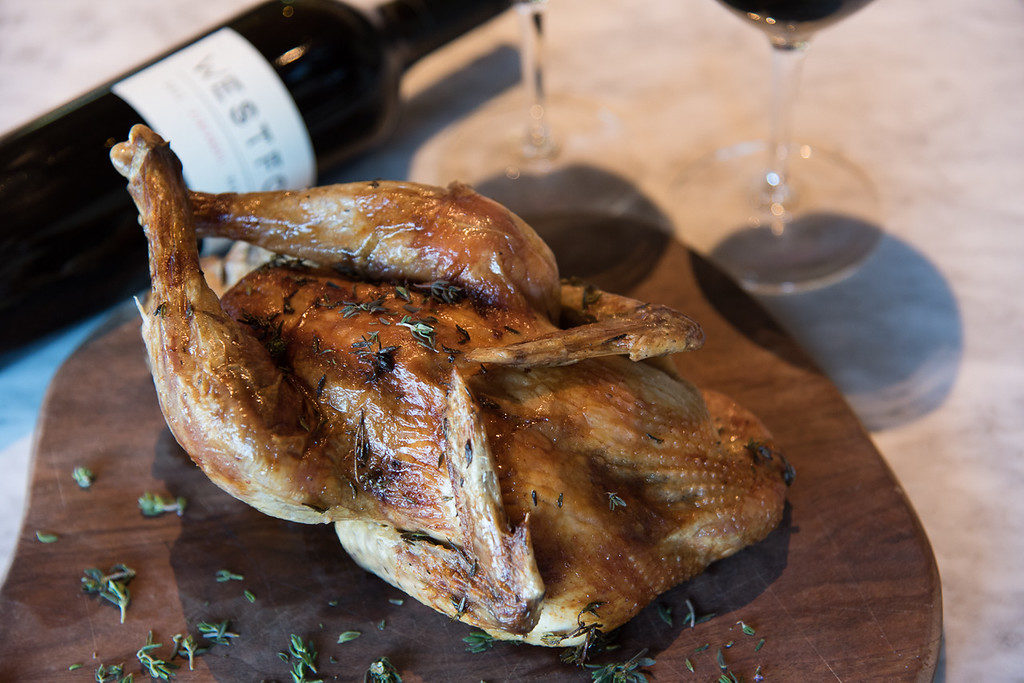
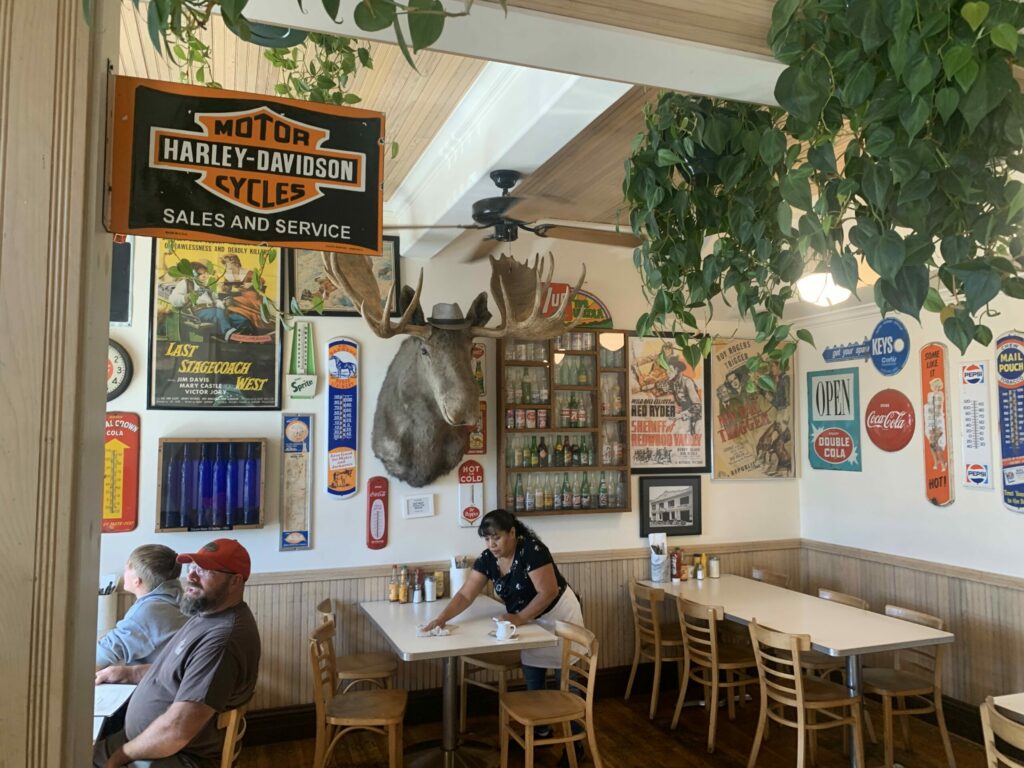
A stone’s throw north, the Bluebird Cafe is a great place for breakfast or lunch. Say hi to the giant moose mounted on the back wall (“some people call him ‘Marty,’ some people call him ‘Bullwinkle,’” says server Sharon Kyriakos) before you dig into a Bluebird Benedict or a blueberry blintz.
And five miles east of town, the UC Hopland Research & Extension Center offers classes in farming and animal husbandry. If you’re lucky, you might see a few wobbly newborn lambs just getting their feet under them.
Early winter is a delightfully slow time of year in Hopland, but even in the summer this southern Mendocino hamlet never strives for the trendy hustle-and-bustle of wine destination towns to the south.
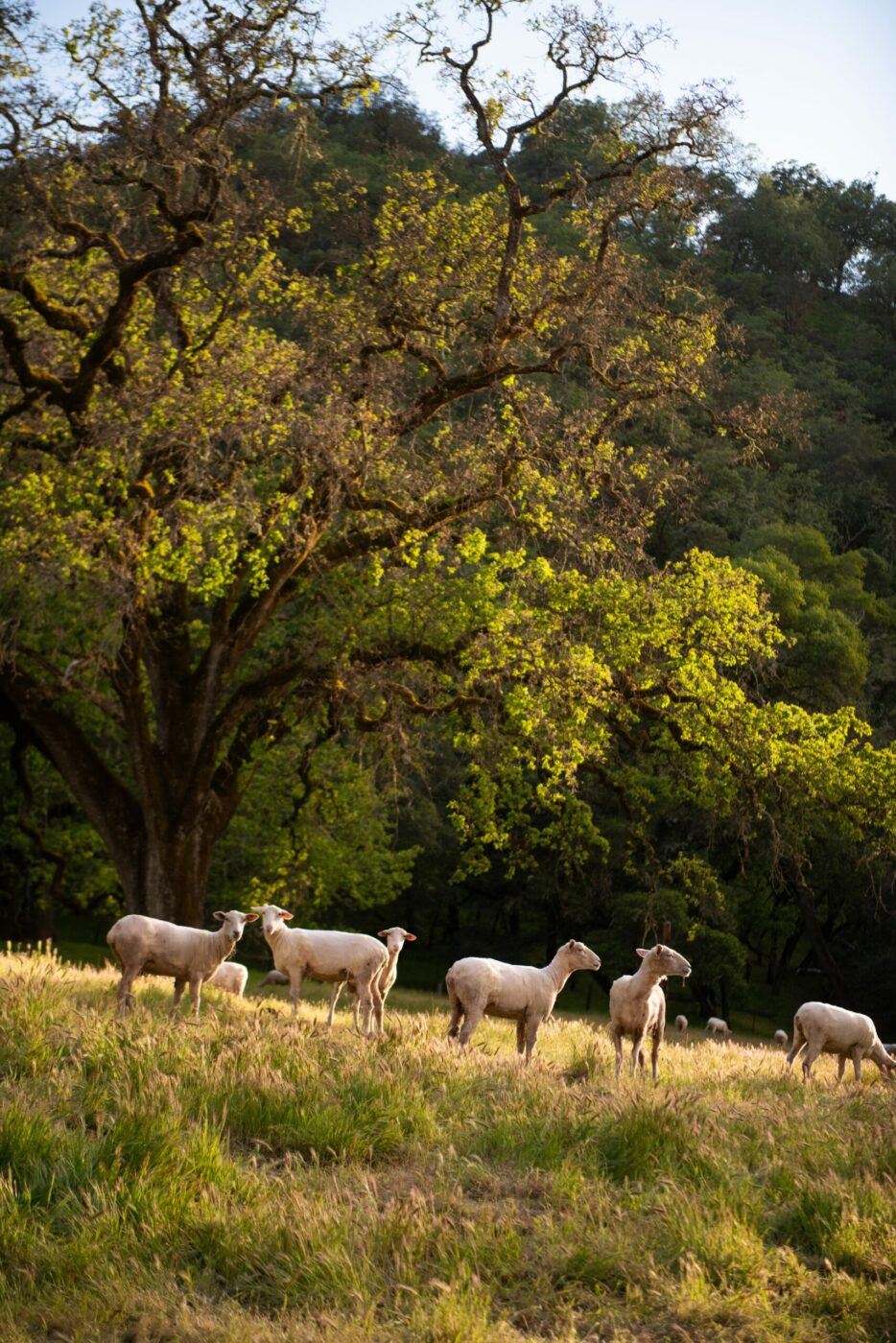
“Hopland is still sort of that unknown place that you pass through,” says Thatcher Hotel general manager Amy Pardini. “You’re going 65 miles an hour on Highway 101, and you’re brought down to 35 miles an hour for a blip, and then you’re back to 65 miles an hour again. A lot of people don’t really even see us.”
But they should.
Where to visit
Thatcher Hotel
This copper-steepled Victorian boasts 18 updated modern rooms and a pool and spa. 13401 Highway 101, 707-723-0838, thatcherhotel.com
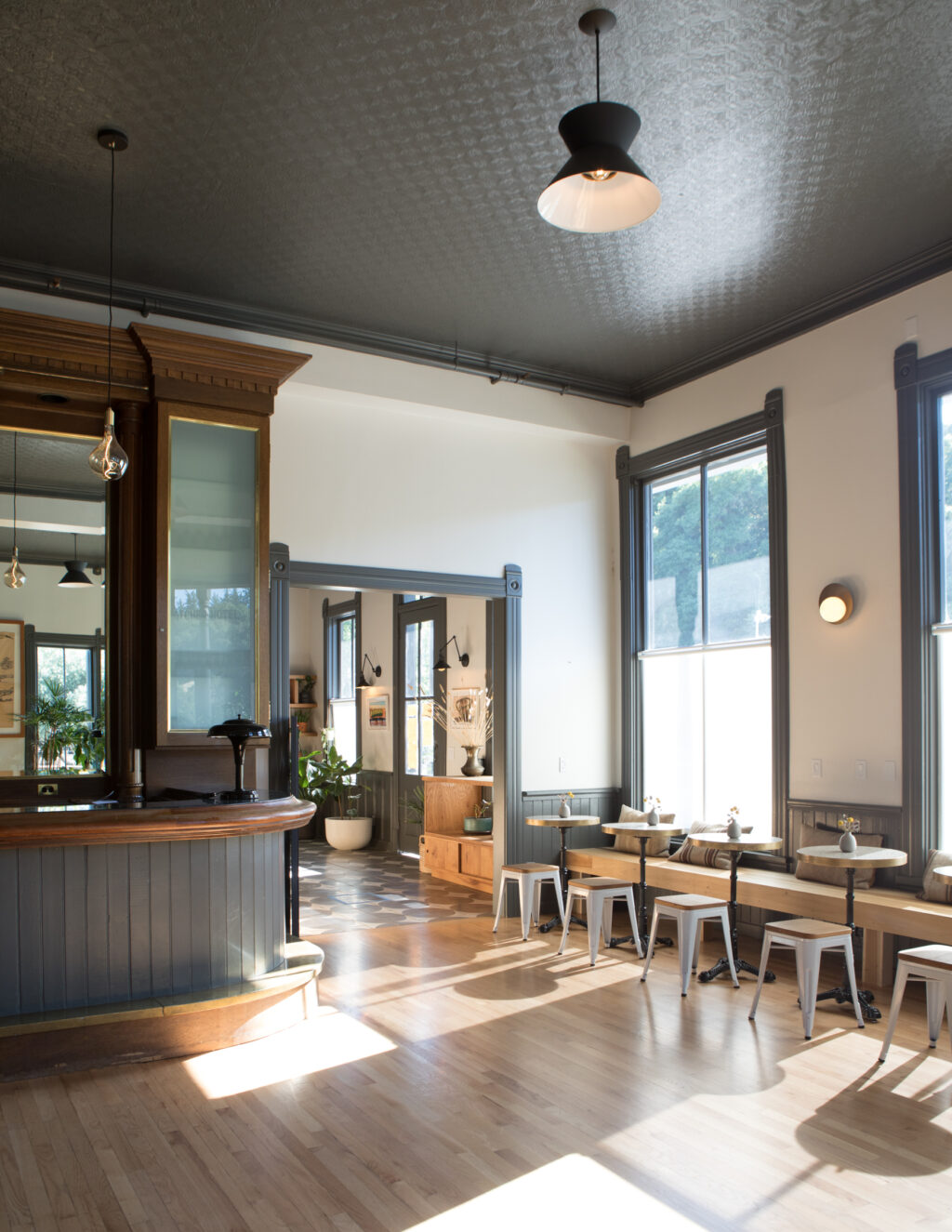
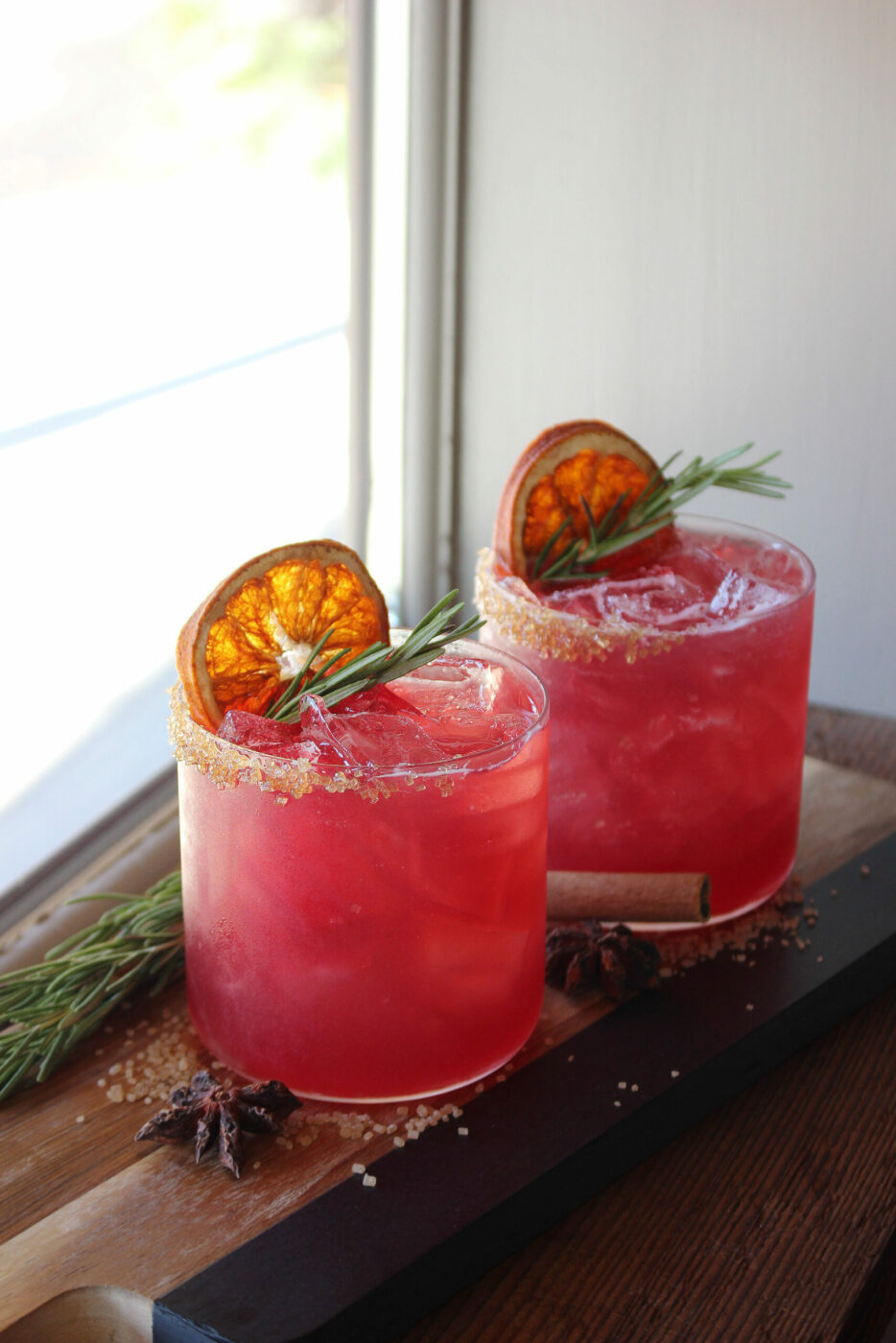
The Golden Pig
Holiday drinks at this “farm-driven” locally sourced restaurant include the Hopland Toddy with Stave Robber Ryed Bourbon, Rapscallion Spiced Apple liqueur, lemon juice and honey. 13380 S. Highway 101, 707670-6055, thegoldenpig.com
Campovida
Look for Italian varietals like Nero d’Avola, Nebbiolo and Negroamaro at this organically farmed vineyard and winery. 13601 Old River Road, 707-744-8797, campovida.com
Bluebird Cafe
This roadside diner is reminiscent of a Southern greasy spoon, but with a moose watching over everything. 13340 Highway 101, 707-744-1633
UC Hopland Research & Extension Center
This 5,300-acre educational facility offers guided hikes as well as classes like Sheep Shearing 101. 4070 University Road, 707-744-1424, hrec.ucanr.edu
The post The Hidden Town of Hopland Is Eager To Share Its Treasures With Visitors appeared first on Sonoma Magazine.
]]>
At the holidays, a family of artists brings to life an interior landscape of natural wonders in their Alexander Valley home.
The post Creative Family Transforms Healdsburg Home With Handcrafted Design appeared first on Sonoma Magazine.
]]>






Morgania Moore and her husband, Brook Bannister, both have deep family ties to the rural Alexander Valley outside Healdsburg. As a child, Moore spent many weeks visiting the home her grandmother built in the Soda Rock area near the Russian River. Bannister’s father had a place nearby, and Bannister grew up fishing and swimming in that same stretch of river, though the couple didn’t meet until they were in their 20s.
Now raising their 11-year-old son, Monroe, in the home that Moore inherited from her grandmother, the creative family is deeply connected to the land and to the handcrafted spaces they’ve brought to life together.
“This house, as the crow flies, is very close to the house my dad built in 1978,” says Bannister. “It was on the edge of these huge expanses of cattle range and maybe a few vineyards. There weren’t any other people around, and you could go out and walk forever and feel like you were out in nature. So this is really close to that; it has the same kind of feel.”
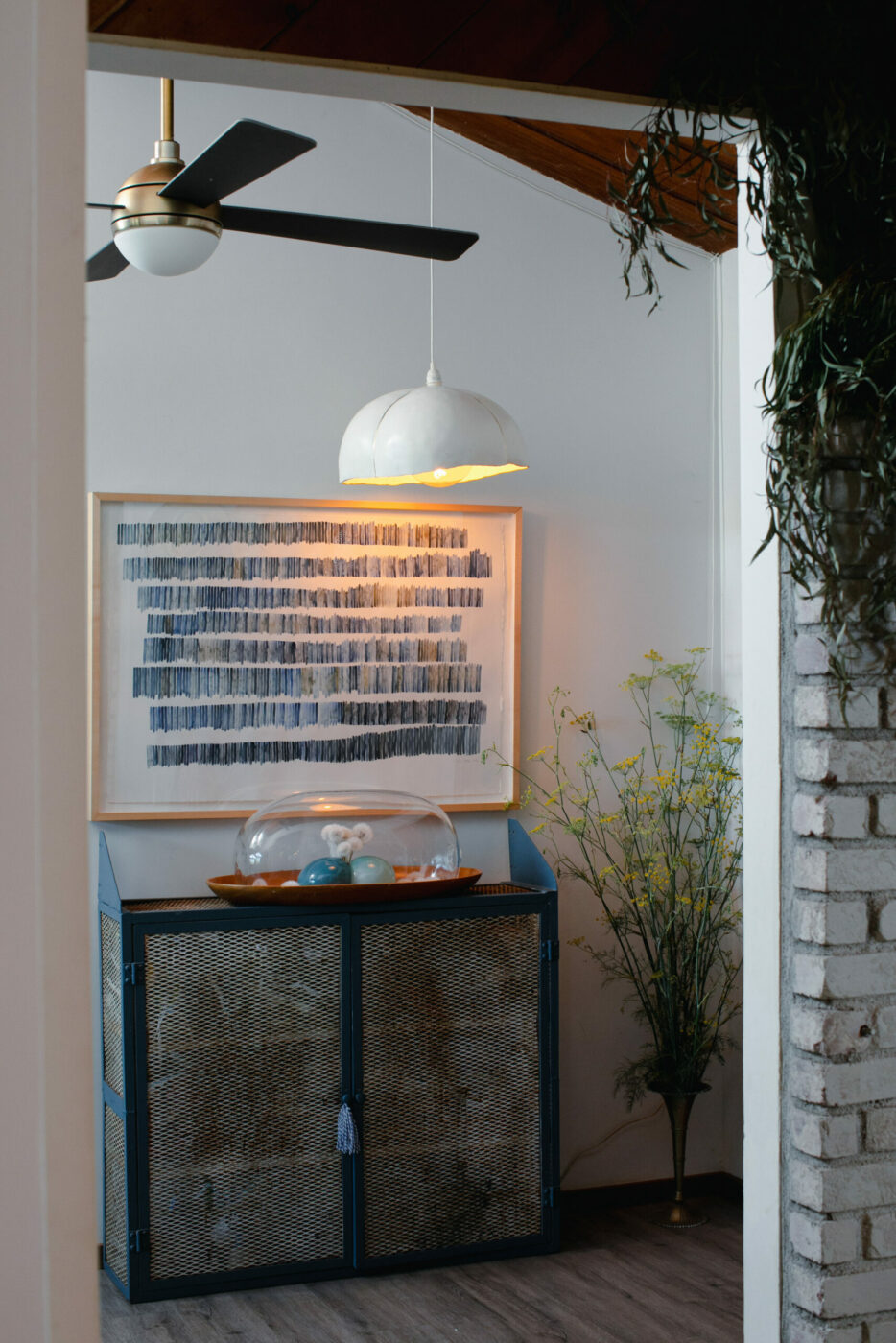
The low-slung, stick-built 1970s cottage and adjacent shared studio unfold in a series of imaginative rooms that bear the mark of a family captivated by craft. Bannister, a winemaker, musician and woodworker, has built much of the home’s furniture, from tables and shelves to kitchen cabinets. Moore, whose creativity extends from lighting and floral design to jewelry and textiles, has filled the rooms with large-scale foraged finds from nature. And Monroe, who attends a nature school near Forestville, plays music with his dad and oversees a massive Lego operation.
There’s space enough for the family to be creative, each quietly absorbed in solitary pursuits in different parts of the home during the day. As the afternoon wanes in the early darkness of winter, they circle back to the kitchen to talk, read and make dinner together.
“We’re all so individually into whatever we’re into. So we try to give each other a lot of room and patience to work on projects,” says Bannister.

“One of the things about having creative impulses is you dig the hole, and then you find your way out,” he says. “That’s how interesting things get made — but it’s also a more difficult process at times.”
Moore and Bannister wander into art projects the way others might pick up a book, following ideas as they come. They’re drawn to the possibility in the curve of a piece of bone, the palette of river stones, the shape of a piece of recycled metal. Bannister translates these inspirations into furniture or music, while Moore sculpts overscale pendant lights in papier-mâché, braids fabric into textured cushions and twists reclaimed fireplace screens into large-scale installations. Entire tree limbs brought inside arch over seating areas, and finds from Moore’s years spent on film sets populate the scene. It’s not just a cabinet of wonders, but an entire home of artistic imagination and creativity.
They both want to honor the house’s humble, artsy history and stay true to its bohemian, 1970s roots. “I had a couple friends who were interior designer people come through, and they were like, ‘Paint the ceiling in here, and brighten it up,’ and do all this stuff. And I just can’t do it,” laughs Moore. “There’s something about it. The old is still here, and I’m trying to bring in some new. But there are stains and marks everywhere that represent years and years of life in this house.”
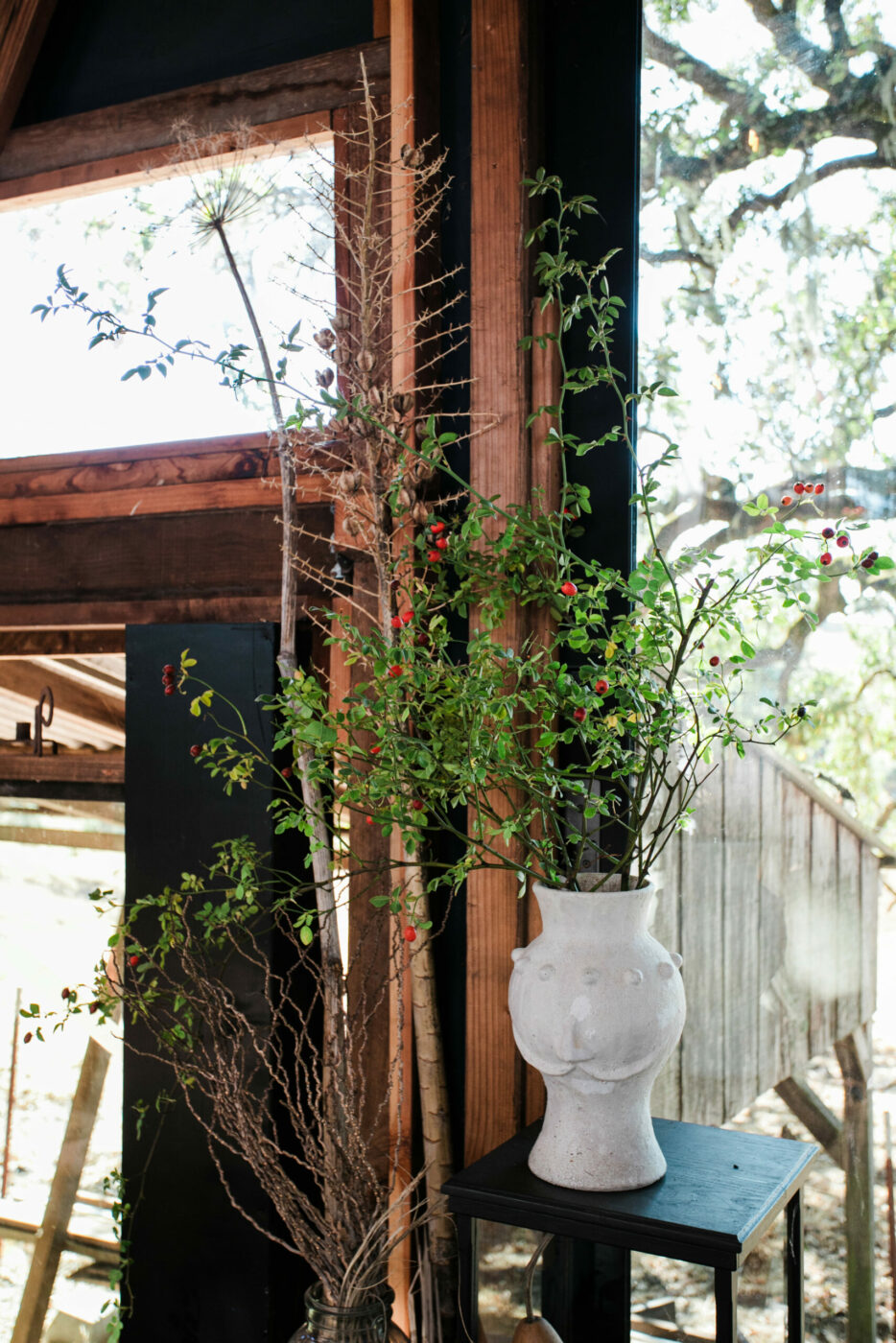
There are years of life and history in the surrounding hills as well. Winter rains uncover clay and pebbles that Moore collects and brings back to her studio to wire into jewelry. The rains also rejuvenate the river flows and give a flush of green and gold to the landscape. “There are materials all around us…That’s country life, you know?” says Moore.
The crispness of early winter in the Alexander Valley means vineyards turning colors and native plants starting to grow back. “Winter isn’t empty; it’s really beautiful. More sculptural for sure, because the leaves are off the oaks, and the grasses are laid down,” says Bannister. “You can see the shapes of the branches and how they’re framed, and you can really see a large swath of the valley from the house.”
A few years back, a winter storm washed up the waterlogged trunk of a huge black walnut tree onto a nearby sandbar of the Russian River. Where someone else might see a tangle to clear away, Bannister saw a once-in-a-lifetime project. He and a friend cut the walnut into logs and hauled them out of the river to mill into slabs, which took a couple of years to cure. Stained and shaped into live-edge cabinet fronts, that walnut is now the hallmark of the family’s character-filled kitchen.
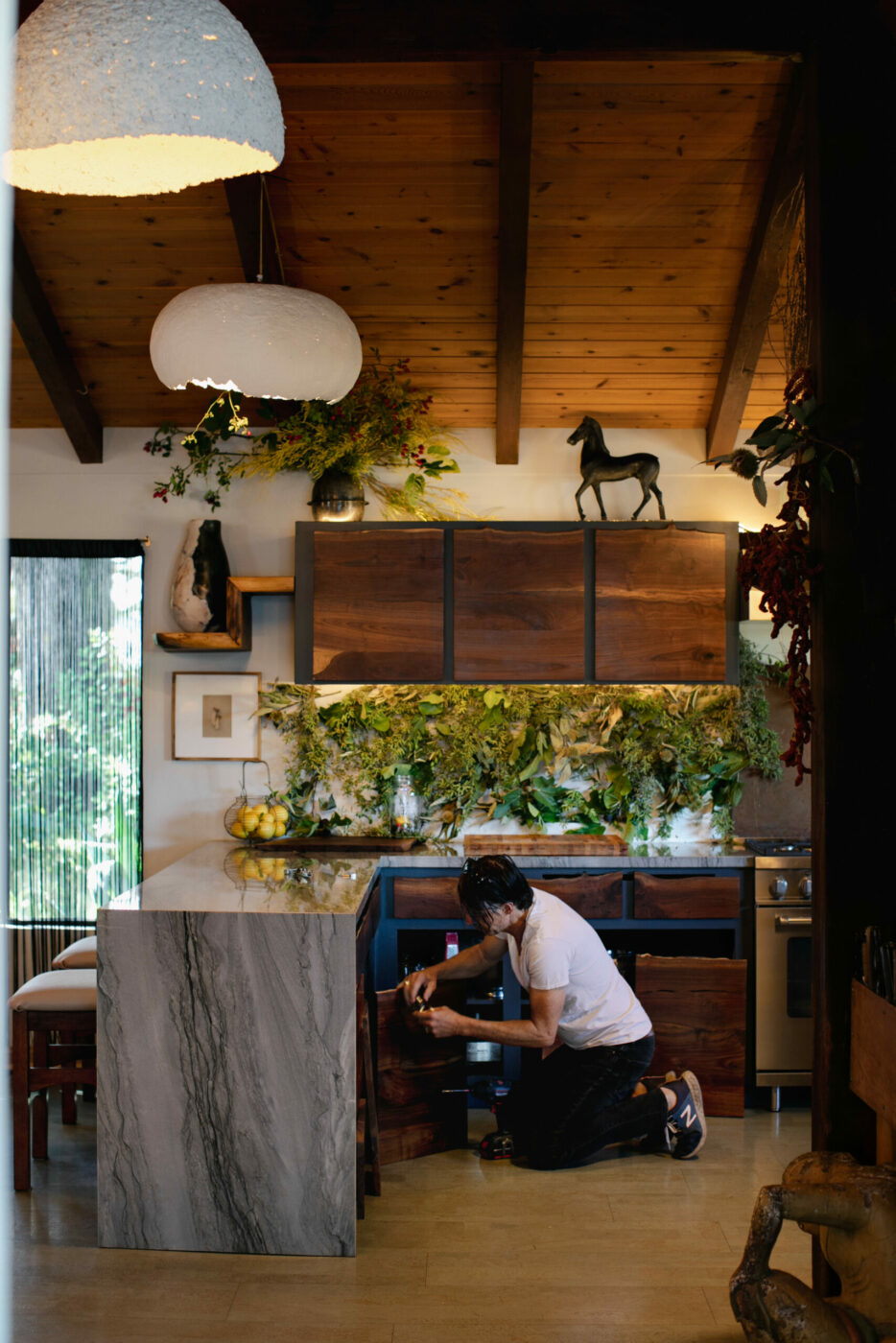
“To start with something as crazy as a giant tree lying on the bank… it’s kind of a long, interesting process where you have to be patient and have some faith,” says Bannister. “Only later on do you find out what you’ve got.”
This sustainable, local approach to craft is deeply resonant for Bannister and Moore, who are motivated by a desire to conserve the land for the future and their young son.
“We have cut down millions of trees that ended up just being wasted. I’ve always just hated that, how little value is placed on keeping old-growth trees in the forest and not cutting them down,” says Bannister. “So when I got interested in making furniture, I was inevitably pushed towards salvaged and reclaimed stuff. It’s just more beautiful than anything you can buy from a supplier. I’m not interested in making stuff out of trees that came out of rainforests.”

Monroe explored carving spoons from the same walnut that Bannister used for the kitchen cabinets. In fact, the couple often find themselves drawn to the same stones, clay and other natural materials. “That’s the cool thing,” explains Moore. “Artistically, we don’t always go together, but eventually Brook and I end up at the same spot.”
And as the family wanders through the chapters of their creative life, the spaces of their home continue to evolve. “You use a room one way for a while, and then you want to do something different with it,” says Bannister. “You look at it as a template.”
“The house is like a canvas that receives your creativity as it comes. It’s seeing what happens over time.”
The post Creative Family Transforms Healdsburg Home With Handcrafted Design appeared first on Sonoma Magazine.
]]>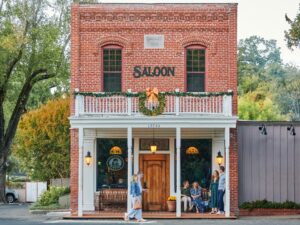
Renowned novelist Jack London is still Glen Ellen's claim to fame — but rustic shops, historic sites and gorgeous hiking experiences are what lure countless visitors.
The post Glen Ellen Has Everything To Make You Feel Glad To Be Alive appeared first on Sonoma Magazine.
]]>






On one hand, Glen Ellen is the town that Jack built. Nearly every sign references freewheeling roustabout author Jack London, from the burger on the menu at the local watering hole to the lively miniature boat races on Sonoma Creek each spring.
But on the other hand, even if the “Valley of the Moon” author had never set foot in this charming village, it would still lure countless visitors looking to get away and feast on everything that ripens around this enclave at the base of Sonoma Mountain.
“It’s the kind of place where everybody knows everybody, but we love sharing it with newcomers,” says Kim O’Donnell, event manager of the saloon and adjacent Jack London Lodge. “Tourists come into the saloon and hang out with the locals, and hours later they leave as friends.”
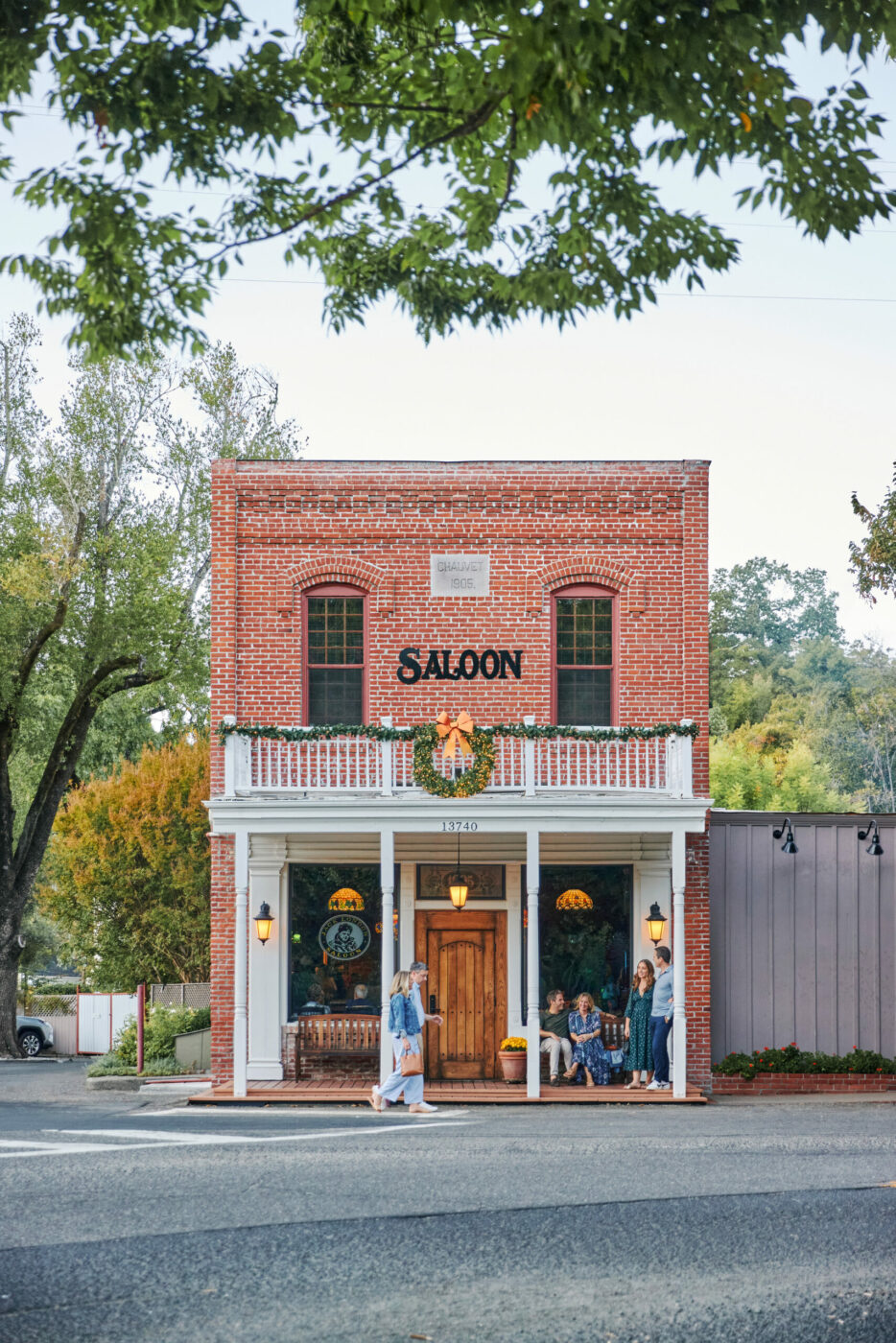
A Dickensian scene unfolds each year in front of the saloon in early December when a vintage carriage pulled by majestic Percheron draft horses picks up visitors for sing-along carols.
As in any French country village, a boulangerie is at the heart of daily life here. The rustic Les Pascals, run by husband-and-wife team Pascal and Pascale Merle, originally from Lyon, France, and their son Enzo, always makes extra bûches de Noel and peppermint mochas for the holidays. The copper rail that runs along the back wall of the cafe was rescued from a 1960s biker bar once located in the 1906 building next door.
The most coveted table in town is at Glen Ellen Star, where chef Ari Weiswasser finds art in seasonal menus that spotlight wood-fired vegetables, whole-roasted fish and wagyu steak. Wineries and tasting rooms abound, from Benziger to Arrowood to sixth-generation family vintner Katie Bundschu’s Abbot’s Passage. But by far the most unique experience is at Dane Cellars, where the tasting room is housed inside an enormous, hundred-plus-year-old redwood wine tank.


For a breathtaking, seasonal hiking experience, meander through the Sonoma Botanical Garden, a carefully curated Asian woodland that comes to life every fall with Amur maple leaves turning garnet beside golden chestnut trees in November, followed by the crimson leaves of five-lobed maple and beautyberry trees in December.
Of course the main attraction has always been Jack London State Park, as locals like Wine Country Trekking owner Greg Guerrazzi freely admit. “He’s still our claim to fame.”
Wander through the “The House of Happy Walls” museum, see the cottage where London wrote novels and short stories, and hike to his grave and his dream house, “The Wolf House,” which tragically burned down in 1913.
Memorialized in a painting at the saloon, London once described a late afternoon horse ride this time of year, as “the grapes on a score of rolling hills are red with autumn flame” and “wisps of sea fog” settled across Sonoma Mountain. “I have everything to make me glad I am alive,” he wrote.
More than a century later, Glen Ellen still evokes that feeling.
Where to visit
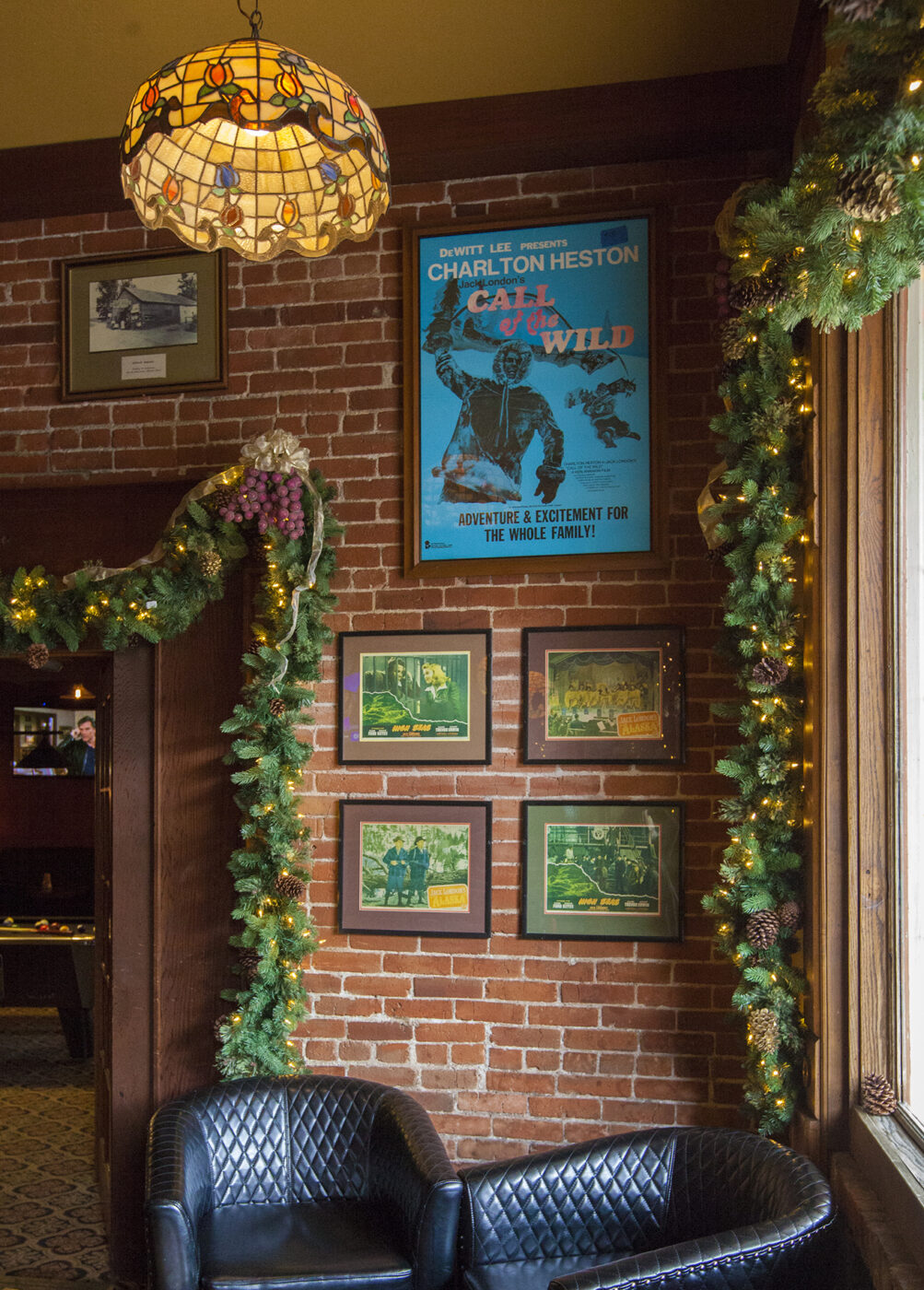
Jack London Saloon
This locals’ favorite watering hole, once known as “the Benzigers’ lower office,” according to the manager, may as well be a museum with all the Jack London memorabilia on the walls. 13740 Arnold Drive, 707-9963100, jacklondonlodge.com
Les Pascals
Quick with a flaky croissant or a fresh baguette, the French owners say Glen Ellen reminds them of old Lyon, the city where they started making Buche de Noel as teenagers. 13758 Arnold Drive, 707-934-8378, lespascalspatisserie.com
Glen Ellen Star
This cozy Michelin-recognized restaurant revolves around the wood oven, from the rustic pizzas to the whole branzino. Look for festive holiday lights on late sculptor Chuck Gillet’s funky water tower across the street. 13648 Arnold Drive, 707-343-1384, glenellenstar.com
Dane Cellars
Tastings inside a historic redwood wine tank, by appointment. 14300 Arnold Drive, 707-529-5856, danecellars.com
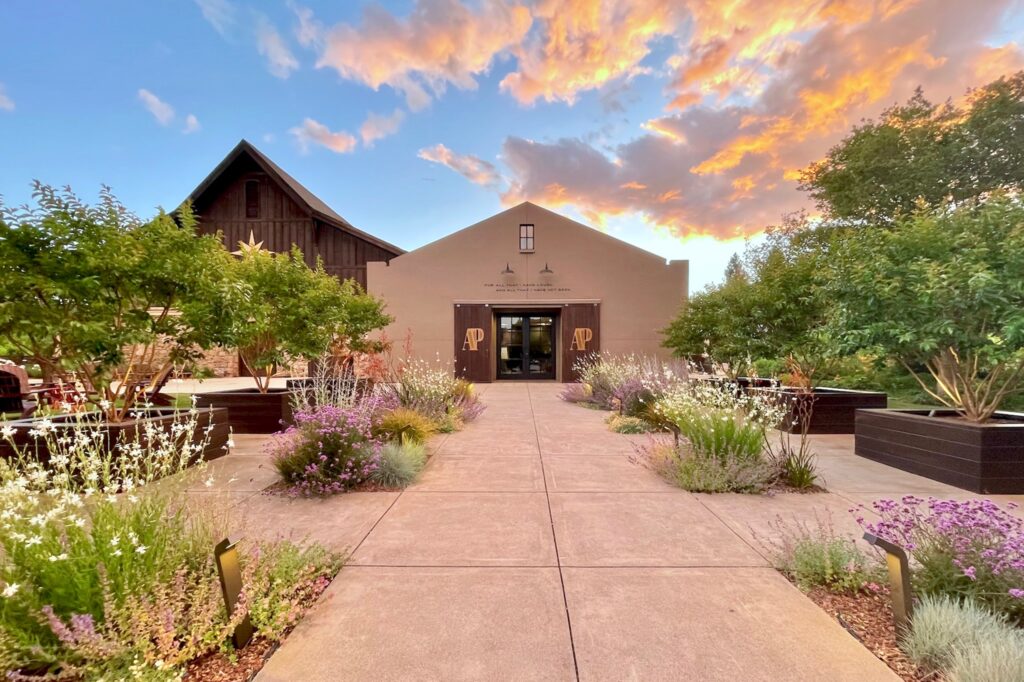
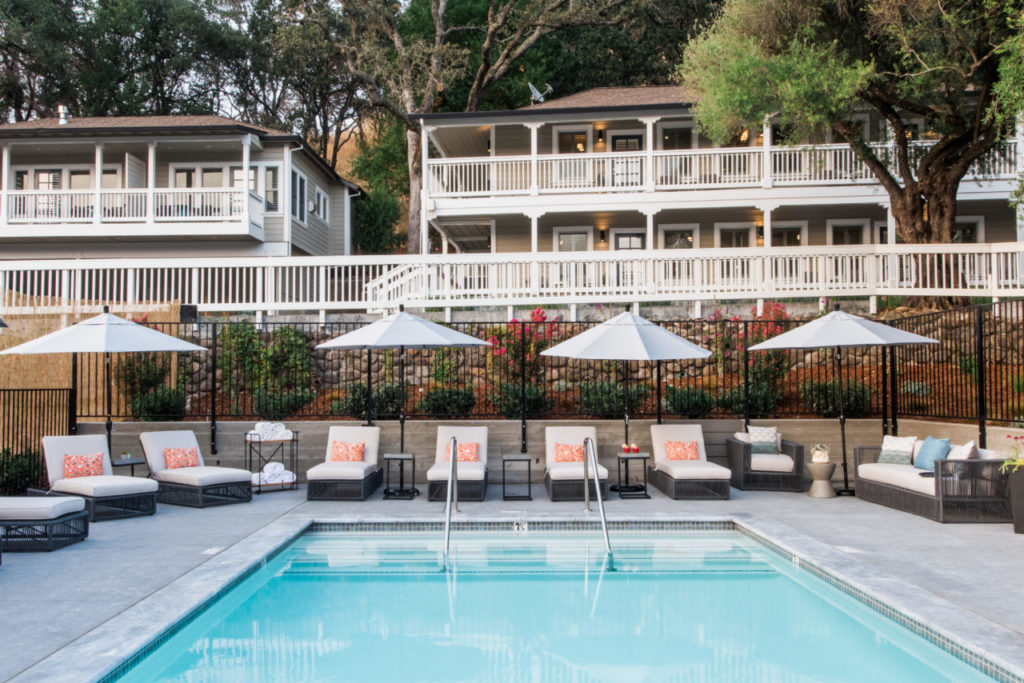
Abbot’s Passage
Look for a holiday photo booth, face painting, and custom clothing and home goods at the annual Winter Market on Dec. 8, plus wines and home goods any time of year. 777 Madrone Road, 707-939-3017, abbotspassage.com
Olea Hotel
This idyllic boutique hotel, nicely remodeled after the 2017 fires, is clustered around a heated pool with views that overlook the valley. 5131 Warm Springs Road, 707-996-5131, oleahotel.com
Sonoma Botanical Garden
Walk among gorgeous plants like Japanese barberry and harlequin glorybower at this Asian woodland park. The nonprofit garden hosts holiday table centerpiece classes featuring berries, pinecones and fresh greens. 12841 Hwy. 12, 707-996-3166, sonomabg.org
Jack London State Park
Bring good walking shoes because there’s plenty to explore, from the ruins of the Wolf House to the House of Happy Walls museum built by the acclaimed author’s wife, Charmian, after he died in 1916. 2400 London Ranch Road, 707-938-5216, jacklondonpark.com
The post Glen Ellen Has Everything To Make You Feel Glad To Be Alive appeared first on Sonoma Magazine.
]]>
Jennifer Ilonzeh, owner of Santa Rosa-based Plant Magic by Ndidi, concocts seasonal teas and elixirs driven by a community of fellow plant lovers.
The post A Santa Rosa Herbalist Blends Teas That Honor Her Nigerian American Roots appeared first on Sonoma Magazine.
]]>






As a child growing up in Texas, Jennifer Ilonzeh had an unusual hobby. She and her sisters liked to visit self-serve soda fountains and compete to see who could blend different flavors to create the most delicious drink.
“Luckily, I’m really good, and I always won,” laughs Ilonzeh.
Now, a couple of decades later, Ilonzeh has upped her game as the owner of Santa Rosa-based Plant Magic by Ndidi, a line of hand-blended, small batch organic teas and other wellness elixirs. The title of the business is taken from Ilonzeh’s middle name, which means patience in Nigerian.

Ilonzeh’s winter immunity tea combines organic rooibos, linden, elderberries, elderflowers, dried ginger, lemon balm and echinacea root for a warming dose of antioxidants and vitamin C on a chilly winter day.
“It helps if you feel a flu approaching or have been exposed to someone sick,” Ilonzeh says. “Plus, it’s really delicious.” In winter, she likes to make hot toddies using her own immunity tea blend as a base, adding brandy, honey and a squeeze of lemon.
Plant Magic by Ndidi also includes a blend of tea that supports healthy rest, made with California poppy and chamomile, and an “uplifting” tea that includes hawthorn, linden, lemon balm, holy basil and rose petals. Ilonzeh has broadened her line to include apothecary products like oils and body butters, plus a tincture of herbs taken by the dropperful to unwind before sleep.
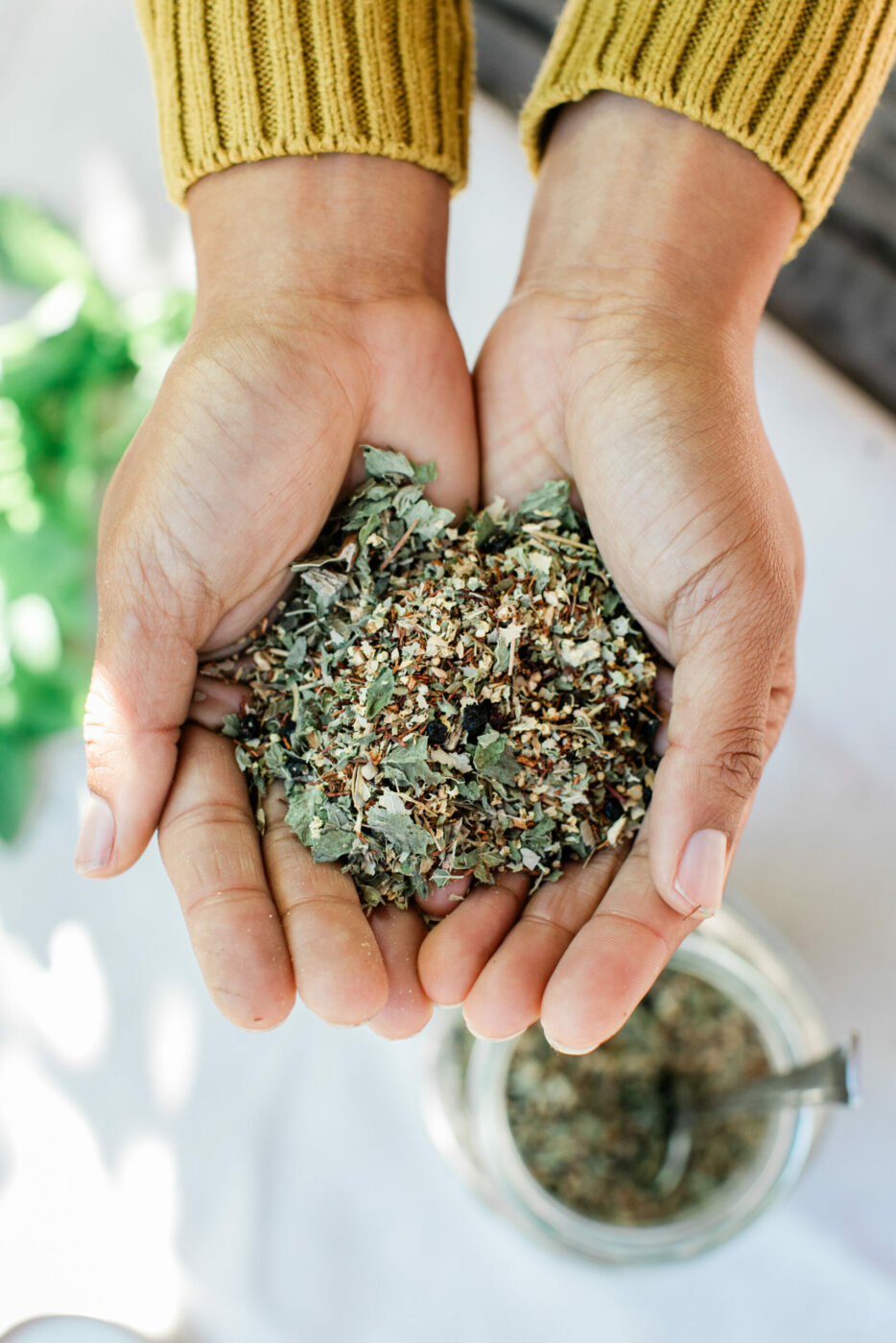
The young entrepreneur has traveled a long road to Sonoma County, a place she was drawn to for its deep agricultural traditions as well as its well-established school of herbal medicine, the California School of Herbal Studies in Forestville. Many types of herbs thrive in the climate of Sonoma County, she notes.
Ilonzeh gathers some herbs for her organic teas at Bramble Tail Homestead, the medicinal plant gardens at Green Valley Farm + Mill outside Sebastopol. She also grows some of her own and forages on friends’ properties. She’s been known to pocket handfuls of star jasmine she comes across while out on walks and has even traveled to the High Sierra to harvest arnica at the source.

Ilonzeh grew up in a large immigrant family, the second oldest of five daughters. Her father, who loves plants and gardening, came to the U.S. from Nigeria for college in Virginia.
“He had seen the university pamphlet, but the photos were taken in the summer, and he didn’t speak much English to ask questions,” recalls Ilonzeh. “When winter hit, he’d never seen snow before, and he didn’t even own a jacket.”
He met Ilonzeh’s mother, who has family roots in Great Britain and Poland, in Virginia, and the couple later moved to Texas, where there was a large Nigerian expat community.
The warmer Texas climate allowed Ilonzeh’s father to begin gardening again. He planted vegetables and flowers with seeds he’d brought from Nigeria, allowing friends in their Nigerian American community access to ingredients they couldn’t find in local markets, like peppers and greens. Ilonzeh spent many hours in the kitchen on Sundays with her mother as she prepped meals for the family of seven.

In her 20s, Ilonzeh moved to Maui, where she was captivated by the island’s remarkable flora. “The beauty and aromas of the flowers were something I could never imagine,” she says.
She bought a manual to identify the native plants and hiked everywhere, along the way learning to name-drop Latin plant names and becoming an expert at making flower potions for friends. After time in New York and southern California, she arrived in Sonoma with her partner, who was so supportive of her path that he created a spreadsheet of all the places on the West Coast with top holistic schools to help them choose where to settle.
In the couple’s Santa Rosa kitchen, she concocts teas and tisanes with ingredients that change with the season, driven by Sonoma’s natural abundance and a strong local community of fellow plant lovers. “There’s always someone growing something and has extra they’re happy to share,” she says.
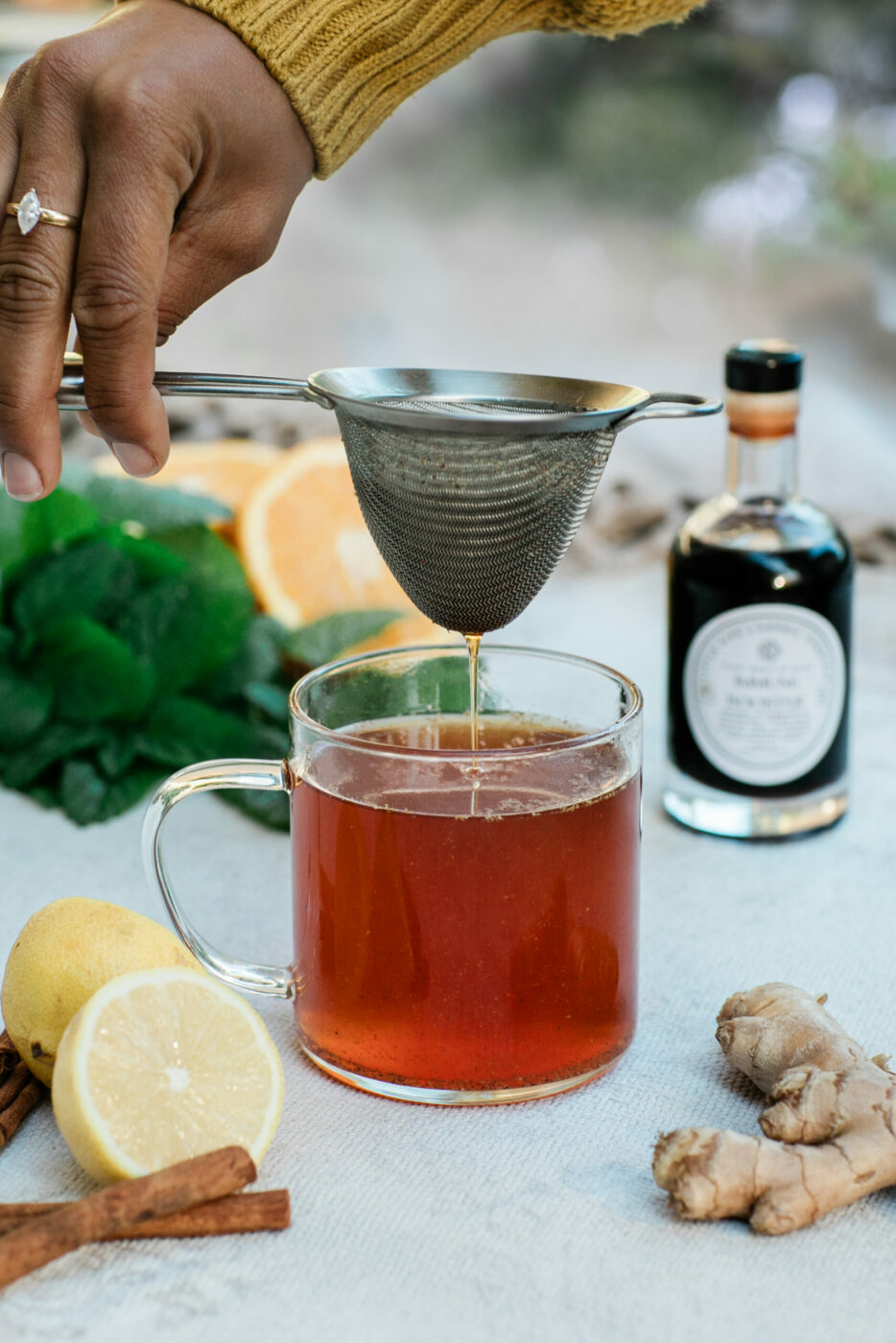
In summer, recipes might include dried hibiscus and locally grown lavender, while in winter, she spikes dishes with plenty of ginger, cayenne, thyme, oregano and other strong flavors. At the holidays, she salutes the season with homemade cordials to give to friends, working with ingredients like elderberries, rosemary and kola nuts in a base of alcohol.
As she develops her recipes, Ilonzeh finds meaning in talking with clients and friends to figure out their needs.
“Who am I blending it for? There’s always something that people need, whether it’s sleep concerns or digestion issues or nervous system support. I can just sit and listen and assess how they look or how they’re moving their body. And then we can figure it out together.”
Jennifer Ilonzeh’s line of teas and herbal products, Plant Magic by Ndidi, is available through her website, at Made Local Marketplace in Santa Rosa, and at the store at Green Valley Farm + Mill in Sebastopol. plantmagicbyndidi.com

Fire Cider
Ilonzeh sips an ounce of this tonic daily to ward off colds. She notes the recipe is highly adaptable to different types of citrus, peppers and herbs. A good amount of honey is a must. Ilonzeh uses honey from her herbal school classmate, Candice Koseba of Sonoma County Bee Company.
• 1 orange, roughly chopped
• 2 lemons, roughly chopped
• 1 small (1-inch) piece horseradish, grated
• 1 onion, roughly chopped
• 6 garlic cloves, whole
• 2 serrano chiles, sliced into rounds (seeds optional)
• 1 medium (3-inch) piece fresh ginger, grated
• 1 handful fresh rosemary (about 1/2 cup)
• 1 handful fresh thyme (about 1/2 cup)
• 1 handful dried elderberries (about 1/2 cup)
• 1 handful fresh rose hips, or fresh or dried hibiscus, chopped (about 1/2 cup)
• Raw apple cider vinegar
• Raw honey to taste (about 1/4 cup)
Combine all ingredients except vinegar and honey in a half-gallon canning jar. Pour in enough apple cider vinegar to fill the jar to within a half-inch of the top. Insert a small square of parchment paper between the jar and the metal lid so the lid doesn’t react with the ingredients, and gently tighten the lid.
Place in a dark, cool spot for four to six weeks, gently shaking once a week. When the mixture smells rich and pungent, strain out the contents and discard. Warm the honey in a water bath for a few minutes until it is thin and stirs easily. Add the warmed honey to the mixture to taste, and stir to combine. Fire cider will keep, refrigerated, for up to three months.
The post A Santa Rosa Herbalist Blends Teas That Honor Her Nigerian American Roots appeared first on Sonoma Magazine.
]]>
After the death of an unhoused woman in a local park, a newspaper columnist faced a mystery deeper than she could have imagined.
The post Grace Lived Unapologetically in a Santa Rosa Park. Her Death Brought the Community Together appeared first on Sonoma Magazine.
]]>






Barry Maahsen remembers his friend not looking well. Something was off.
He’d arranged for the two to meet for coffee over the summer in Santa Rosa. They caught up. They laughed a little. The usual.
What was not usual was her request before they parted. Could he give her a lift home?
Maahsen remembers thinking that was strange. It was barely more than a quarter of a mile. She walked farther than that every day. And she never headed home so early. But he agreed.
“I gave her some money like I usually do and told her I’d see her in a few weeks,’” he said. “She said, ‘OK, I’m just not feeling that good.’ It was like somebody who had a cold.”
The following week, the phone rang in his subsidized apartment in south Petaluma. The stranger on the other end of the line was from a Sonoma County administration office. He had retrieved Maahsen’s number from his friend’s phone. He said he hoped Maahsen could help him. Bewildered, Maahsen kept listening.
The caller explained that Maahsen’s friend, who had been living on the streets for years, had been found deceased in the Santa Rosa park where she had made her home.
It was a gut punch, learning from a stranger that his friend was dead. No foul play was suspected, the man on the phone said. But officials had questions.
The key question? “We are trying to find out what her real name was.”
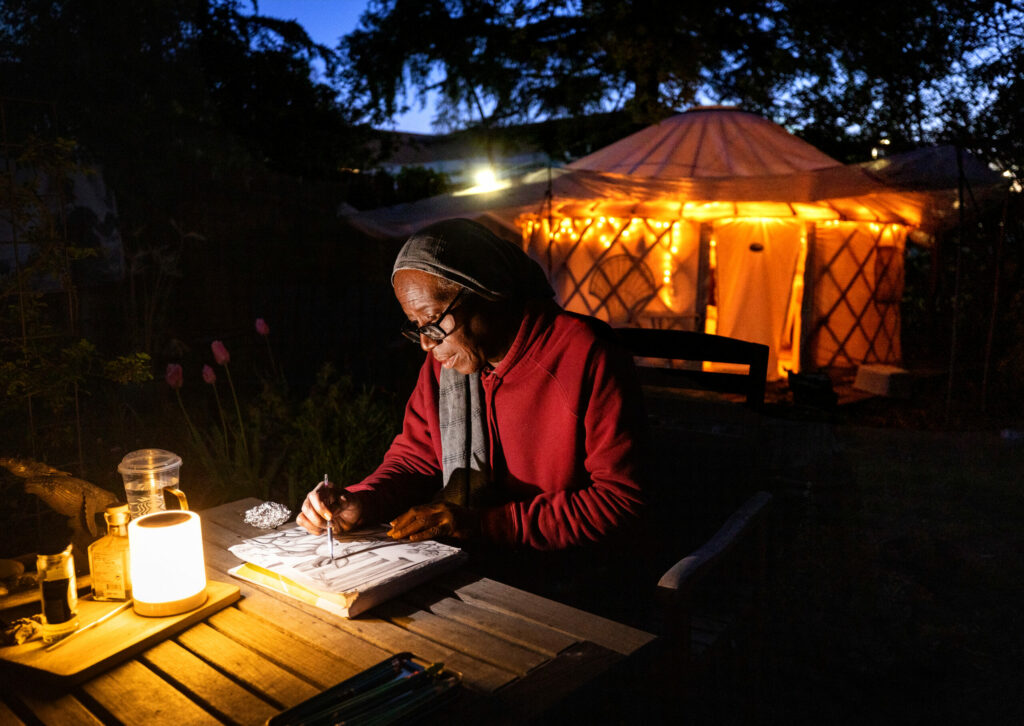
The 59-year-old woman had been found unresponsive in Steele Lane Park on June 26, just after 12:30 p.m. She was one of the approximately 150 deaths in Sonoma County each year in which the deceased has no apparent family.
The woman had lived on the streets. She held no job. She had no pet, no partner, no identification. She was, it seemed, living almost entirely outside of the system. But this woman was far from anonymous.
She was Grace.
At a time when the issue of housing insecurity continues to frustrate citizens and public officials, and when others living on the street seek shelter in discreet, darkened corners away from the judgments of passersby and law enforcement, Grace lived unapologetically in the open. Her home was Steele Lane Park, a small, well-used, 2.4-acre city park in the heart of Santa Rosa.
Over a period of three years, her space in the park grew to include a six-person tent, a grill and a cooler. When those items were confiscated by Santa Rosa Police, she made do with far simpler accommodations — a sleeping bag, a piece of cardboard and an ever-present satchel that held her art supplies and Bible.
Neighbors, as that’s what Grace considered them, allowed her to store some of her things on their porch in inclement weather. One offered her use of an outdoor bathtub and did her laundry once a week. Multiple people spoke of giving Grace a tent over the years.
Dozens of relationships — real ones with highs and lows — developed during Grace’s time at the park. Many others considered her a friendly acquaintance, someone with whom they regularly shared passing greetings.
Visit Peet’s Coffee on Mendocino Avenue or the Starbucks in Mendocino Marketplace and you were almost guaranteed to run into her. Grace became even more well known in the spring of 2023 when I wrote about her for The Press Democrat newspaper.
In interviews, Grace spoke of growing up in Dutchess County, New York, of her beloved mother “Sissy,” of losing two brothers too young.
She said she had been well educated, a career woman who was also deeply unfulfilled. She described herself as cast adrift when her mother died. She spoke openly of her descent into homelessness— but also of her embrace of the lifestyle.
And she spoke of finding God and of serving her community. Our community.
But much of what she said in interviews, much of the story she told her countless friends and acquaintances in Sonoma County, is difficult to corroborate. Her use of multiple names over time makes it nearly impossible.
To me, to friends and neighbors, to the baristas in the coffee shops and the clerks at Safeway, she was best known as Grace. She also used the name Ellynn. And Qua. She answered to all three names at different times and with different people.
But who was she?
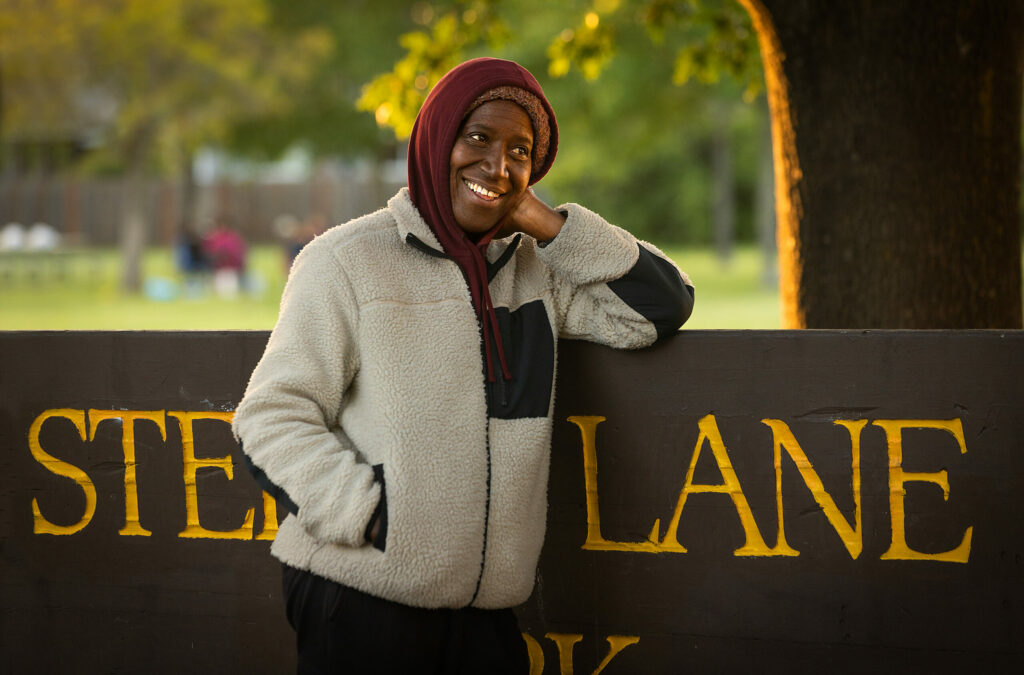
Grace’s story in Sonoma County — and we will call her Grace in this story because it is the name she was most known by — starts largely with Barry Maahsen, the friend who took her to coffee and left her with some money the week before she died.
Grace was new to Santa Rosa and living on the street when Maahsen met her. He thinks the year was 2018.
Maahsen, a lifelong member of a commune known as One World Family, was living with three others in a rented home on Sleepy Hollow Drive in Santa Rosa when Grace walked through the door.
Maahsen didn’t know her as Grace. He called her El.
“El was short for Ellynn,” he said. “Ellynn Grace Cole was what she told us her name was. Other people called her Grace Davis. I never knew her as that.”
One of Maahsen’s roommates had struck up a conversation with Grace at Peet’s Coffee and later invited her to live with them and help care for an elderly member of the commune. There was no pay, but her room and board were provided. “We lived by the axiom, ‘Hold all things common, distribute each according to need,’” Maahsen said.
Grace’s new accommodations were modest, but her needs were met. She slept in what Maahsen described as an alcove with no door.
But over time, the situation frayed. “I would have liked it if she would have tried to support herself with food stamps or something or welfare or whatever, but then she’d have to have ID or whatever and I think that is what stopped her from doing it,” said Maahsen. “For some reason, she didn’t want to.”
In conversations last year, Grace told me that the idea of living with three members of the commune sounded good to her in theory, but that in reality, she felt thrust in the middle of decades of tension between the roommates.
“Living in that home humbled me,” she said. She knew two of the three roommates voted to evict her, with only Maahsen advocating that she stay. But rather than leave voluntarily, she stayed until the police knocked on the door.
“She knew it was coming. She got a notice, at the house,” Maahsen said. “Two big police officers came and she grabbed her stuff and she left.”
I asked Maahsen what she took with her.
“Just what she could carry,” he said. “She never had more than she could carry.”
It’s telling that Grace and Maahsen remained friends. They continued to meet up for coffee, go shopping and spend afternoons together until days before Grace’s death.
Last year, when I asked Grace about leaving the home, she didn’t go into detail.
“When I had it all, God strips you bare,” she said. “He strips you bare.”
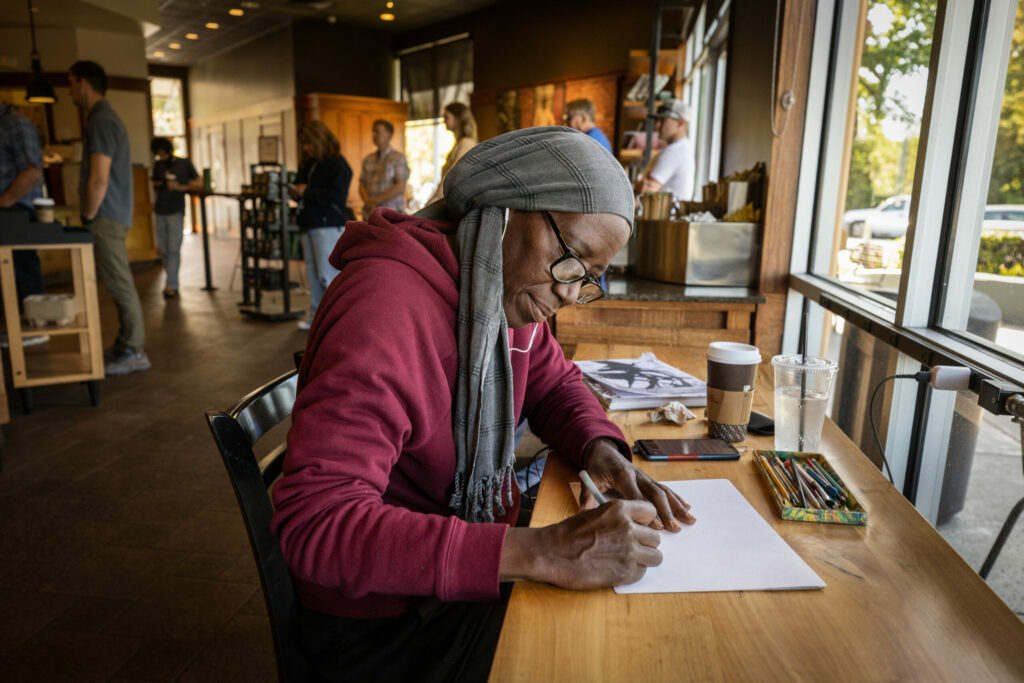
More than just her living arrangement changed on the day Ellynn “El” Grace Cole walked out of the shared house on Sleepy Hollow Drive and headed to Steele Lane Park.
When she returned to the street, she was friendly and outgoing, engaging in easy conversation. She talked with everyone.
But now she always introduced herself as Grace.
Neighbors who live around Steele Lane Park in Santa Rosa remember first seeing Grace in the winter of 2019. She spent days there, sitting on a rock near the park’s large, wooden sign. She would draw. She would read. She would engage with passersby.
But in those early days, it wasn’t obvious that she was spending her nights there.
After the pandemic turned the world upside down in the spring of 2020, Grace took advantage of prohibitions against sweeps of homeless encampments and set down roots, creating a home at the entrance to the park. For a time, a Google Street View of Schurman Drive featured a photo of Grace sitting in a chair and talking with a friend, surrounded by her belongings.
In those early days, some asked her to leave. She refused.
At the time, due to the pandemic, people were discouraged from gathering, even in parks. So Grace had the place largely to herself. She described finding a sense of peace. “When I first started sleeping there, I was exhausted,” Grace told me in 2023.
In time, Grace was accepted. And still later, embraced.
Neighbors credited her with helping monitor the small park, preventing open air drug use and littering and discouraging others from parking their vehicles for long periods. And her neighbors, her community, dubbed her “Amazing Grace.”
For three years, a Santa Rosa Police spokesman said the department recorded not a single complaint related to Grace. One neighbor said he refused to call the police about other unsavory activity at the park because he was afraid it would negatively affect Grace.
And Grace, imbued with natural confidence, believed that she had the right to live there. She’d earned it, she told me. Grace was so resolute in her position there that she left her valuables in and around her tent for hours at a time, spending her days in coffee shops, drawing and socializing.
She cherished the community she had built but was unafraid to flout its norms. She was described as an artist. A philosopher. A neighbor.
But also a conundrum.
She could be prickly. She would sometimes share theories that bordered on conspiracy, sharing links to videos about the dangers of antidepressant medications and vaccinations. She sent me videos suggesting that anarchists were ruining cities like Seattle and Portland. But she also sent an incomplete transcript of George Washington’s farewell speech and a link to a George Carlin stand-up set.
She had no time for public health addiction programs that focused on harm reduction. She regularly called efforts to lift up the unhoused as a massive government con job. She had harsh words for most of the folks who lived on the street.
“If they stopped getting high, most of them would have places to go,” Grace told me last year. “It’s not a homeless problem. It’s a drug problem and it’s an alcohol problem. There are people wanting to be out there. They have been given chance after chance after chance.”
I pushed back. What if people in crisis or in the throes of addiction need support? Need someone to walk alongside them to get clean?
“You can walk side by side with them but watch your pockets,” she said. “You can lead a horse to water but if that horse wants to do crack…” In 2022, an officer with the Santa Rosa-Sonoma County NAACP tried to link Grace with supports: financial assistance, therapy, transportation. The two had struck up a conversation at a coffee shop, according to NAACP branch president Kirstyne Lange.
Over the course of three to four months, there were discussions about how best to support Grace, including trying to get her a laptop. But it wasn’t easy. Grace seemed both willing and wary. “I wouldn’t call it resistance, but there was hesitation,” Lange said.
On top of that, there were practical issues. “I remember she didn’t have anything that could prove her identity or prove her living situation,” Lange said. “I would say the perception was that it felt like too much trouble, the questions, the paperwork. I think that it really felt strenuous.”
And then Grace “kind of disappeared,” Lange said. The phone she was using became unreliable. The NAACP officer eventually reconnected with her but was never able to link Grace with the services they had discussed, Lange said.
Then, in April 2023, Grace’s life was upended.
Sonoma County opened a sanctioned homeless camp on Ventura Avenue, near the park. Days later, officers from the Santa Rosa Police Department posted an eviction warning on Grace’s tent, and two days later, her belongings were removed and placed in police storage. Neighbors believed Grace’s home was collateral damage in local efforts to monitor activity in the wake of the sanctioned camp.
Left with only the bag she had carried to the coffee shop, Grace refused to retrieve her belongings, not even her Bible and art supplies. They took them, she explained, and they can return them.
At the same time, she was friendly and personal with law enforcement officers of multiple agencies. Despite a mistrust of the government, she had faith that Jesus would take care of her. She repeatedly said she had no plan, she simply followed Jesus.
“I’m doing what God tells me to do,” she told me. “It’s amazing.”

After Grace was evicted from Steele Lane Park, her physical footprint became smaller. With no tent, no cooler, no sleeping bag, she disappeared from the park for a while. The phone number I had for her stopped working. I could still find her at Peet’s, but our communication slowed considerably.
I ran into her at Safeway last winter. We walked the aisles together. I bought her a beer and a prepared salad. I noticed she didn’t look well. Her coloring was off. Others, too, told me after her death that she, off and on, showed signs of struggling. Closer to her death, people said she had a cough that wouldn’t let go.
But Grace was Grace. A strong personality, a strong woman. It was hard to imagine her weakened by much.
When Grace was evicted from the park, neighbor Vicky Kumpfer took her in, allowing her to stay in her backyard yurt. Their relationship was real in that it had highs and lows. They had a couple of disagreements over issues of trust. But, as true friends do, they came back together.
They had just mended one of those rifts last spring when Kumpfer, who works as an art consultant, convinced Grace, with some prodding, to show her art publicly. Kumpfer had eight pieces of Grace’s work and was in the early stages of planning a small show when Grace died.
Instead of planning an art exhibition, Kumpfer planned a memorial service. She set a time and got the word out the best she could. It would be held at the park, at the spot where Grace had slept for years.
She assumed neighbors would come, but didn’t know who else.
On a Wednesday afternoon two weeks after Grace died, Kumpfer set up a table and a few chairs, brought fruit and sparkling water. She also brought Racer 5 IPA, which prompted someone to recall aloud the time they tried to buy Grace a Modelo and she declined. She preferred IPA.
About 40 people showed up. Neighbors, yes. But also a retired opera singer who lives in Fountaingrove with her husband. A maintenance worker at Santa Rosa Junior College who took time off from his shift to attend. A special education teacher at a nearby school. A doctor and his wife who live miles from the park. A middle-aged woman who brought her daughter and who could not stop crying.
A man set up an electronic keyboard and played live music. People sang. People wept. People pinned messages to the fence that for years had provided Grace shelter.
“What surprised me was the diversity of the people,” Kumpfer said.
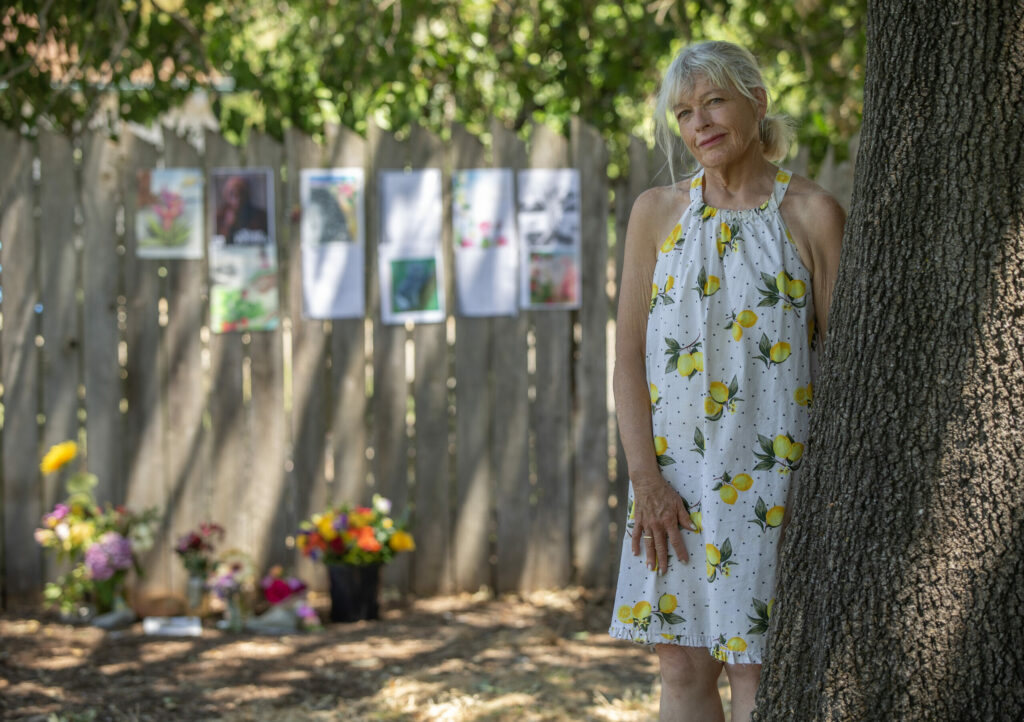
The day before the memorial service, Sonoma County’s chief deputy Public Administrator, Guardian and Conservator, Jennifer Hainstock, emailed me. Her office, Hainstock said, was charged with trying to find Grace’s family, and failing that, identify someone willing to make final arrangements for her.
In the case of deaths where there is no obvious family connection, Hainstock’s office culls information from newspaper stories, social media accounts, online databases. They make calls, they send emails, they write letters.
“We end up with about 45 people a year we just can’t find anybody for,” she said. “Or we find them, and they are, for whatever reason — no money, don’t want the ashes — unwilling.”
Hainstock’s office had not yet found family for Grace. The names they were using in their searches were Ellynn Grace Cole, aka Qua Grace Davis.
In 2023, the Santa Rosa Police Department had her name as Elgrace Cole. At the same time, Grace told me her name was Qua Grace Davis.
When I asked her then about the discrepancy, she told me that at some point she decided she didn’t like people using Qua. Her mom called her that, she said.
She said she “came up with” Ellynn, but didn’t say why. She said it was Barry Maahsen who affectionately shortened it to “El.”
With no identification, the name Grace offered officials at some point in her seven years here is the name that came up when the coroner’s office ran her fingerprints after her death.
It’s the name that appears on her death certificate along with an official cause of death: acute bacterial lobar pneumonia.
The coroner’s office took a DNA sample but did not run it through any database, because a match was found with fingerprints. An additional DNA inquiry would be expensive, said Sonoma County Sheriff’s Office spokesman Rob Dillion.
To have fingerprints turn up in a law enforcement search does not automatically mean the person had a criminal history. Fingerprints can be gleaned from things like the federal Transportation Security Administration files. Or if a person volunteers at a school. Or is a youth coach. “Just because her fingerprints are ‘in the system’ doesn’t mean it’s negative,” Dillion said.
But the name Ellynn Grace Cole?
“The fingerprint that came back to us as a match, that was the name she gave,” he said. “It doesn’t say when that was.”
There might be a reasonable explanation for this. Searches are only as good as the information put into them, Dillion explained. For someone born before the internet age, when official documents were filed on paper, not everything has been moved to an electronic database. Not everything can be found in a “search.”

I also searched for Ellynn Grace Cole. And Grace Davis. And Qua Grace Davis.
And I looked for her mother, too. I called administrators in the Dutchess County N.Y. Records Room as well as New York state’s Vital Records office. I reached out to Vassar College, where Grace said she’d earned a degree. Officials there could find no record of Ellynn Grace Cole, Qua Grace Davis or Grace Davis. I also contacted officials at Marist College, where Grace said she’d worked. Again, nothing.
Which isn’t to say she did not work at Marist or earn a degree from Vassar, just that she didn’t do so with any of the names she used in Sonoma County.
Database searches in a slew of categories — deeds, mortgages, liens, assumed names — found nothing for the three names Grace used here in Sonoma County. I sent a Facebook friend request to someone named Ellynn Cole whose profile picture looked eerily like Grace’s style of painting, but whose public list of friends seemed to be filled with bots. No reply.
I sent messages via Facebook to two real-seeming friends of that “Ellynn Cole” explaining who I was trying to find. No reply.
When I ran the Social Security number listed on Grace’s death certificate through a search tool used by reporters, it returned a 59-year-old woman in Staten Island with a name not remotely close to any used by Grace.
I called her.
She didn’t let me finish my question before cutting me off and hanging up.
So I wrote her a letter, explaining the mystery. I told her a Social Security number associated with a now-deceased woman in California is also linked to her. I sent her a copy of our original story about Grace.
I never heard from her.
And as I searched, I fretted over what role I had played in what could at best be described as a local mystery, but at worst a lie. I’d been unable to confirm much of Grace’s story, so I allowed it to be told through her voice and through the voices of her community.
Those friends and neighbors spoke of Grace’s emotional intelligence and her almost eerie ability to read people. They spoke of her humor as well as her temper. Of her resilience and good cheer in the face of daunting circumstances.
Many of Grace’s friends described her as an outlier, different from other unhoused people — not necessarily part of the divisive debate about how to handle the approximately 2,500 people living unhoused in this county.
Sure, she lived on the street, but she was always well-dressed, she was clean, she was respectful and engaging.
She was different.
But our society and our system of governance is not set up for different. Rules and policies are crafted for the many, not the few.
People like Grace complicate the debate.
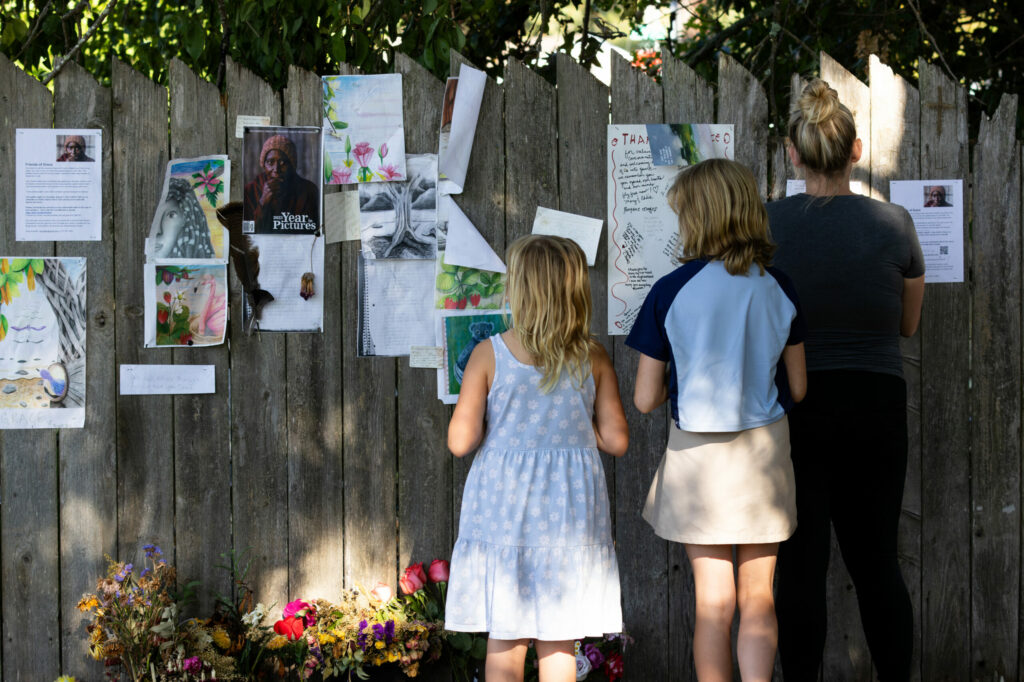
Jennifer Hainstock at the county administrative offices didn’t have success locating Grace’s relatives either. Neighbor Vicky Kumpfer agreed to pay $1,800 for Grace to be cremated and take possession of her ashes. If she hadn’t, a county fund would have been used and the ashes would have been laid to rest in Pleasant Hills Memorial Park in Sebastopol.
There would have been no personalized marker, no name at all. That was unacceptable to Kumpfer. “It was to see that she not go in an unmarked grave, if you will,” she said. “I figured she deserved more.”
Kumpfer held a second memorial service. She again set up a table with fruit and sparkling water, cheese and crackers, and a berry pie. At the back of the table was a black, rectangular container roughly the size of a shoe box with a tightly wrapped bag of ashes inside. The sticker on the front read:
Ellynn Grace Cole
DOB: 8/14/1964
DOD: 6/26/2024
Kumpfer brought brightly colored bags and poured a small amount of Grace’s ashes into bags for those who wanted them. Donations from Grace’s friends reimbursed Kumpfer for the cost of the cremation.
The contributions brought Kumpfer to tears. “I couldn’t handle it. The stories they would have. Short stories in terms of interactions with her, allowing them to express their love for her was a really big part of it.”
Stories.
Grace told us a story of who she was. And in her telling and in the way she lived, we saw in her who we needed her to be.
In interviews with more than 20 people over the course of 18 months, people who knew Grace repeated the same details. She grew up on the East Coast. She was well educated. She’d been devastated by the death of her mother and was a somewhat recent follower of Jesus.
But were the stories she told us about her mother and brothers, her education, her journey west, true? And, perhaps more importantly, does it matter?
Or is her impact on her community — the connections she made here, the way she lived her life and forged relationships with people — the real story?
To the art collector who paid for a stone Grace painted, does it matter if the name she signed on the back was not her given name? To the woman wrestling with the pain of a destructive relationship, is Grace’s wise counsel diminished in any way if that was not her true name? Does the courtesy clerk at Safeway who unburdened her cares about her mother’s mental health issues to a woman she called Grace gain less solace if that in fact was not her name?
And are the countless, truly countless, folks who walked through Steele Lane Park or met her at a coffee shop any less enriched by the conversations they had if she chose to go by a name other than the one given to her at birth six decades ago?
Grace lived as she wanted to and told us her story as she wanted it to be told. No more, no less.
And in turn, we poured our own needs onto her, making her who we needed her to be.
In death, Grace’s story ends. This is what she left us.
It’s a story. And it’s a good one.
The post Grace Lived Unapologetically in a Santa Rosa Park. Her Death Brought the Community Together appeared first on Sonoma Magazine.
]]>
First they came for the schools. Now they're coming for the ranchlands. Like most successful invasive species, wild pigs are survivors.
The post Sonoma’s Wild Pigs Are on the Move in Early Winter. Here’s Where They’re Heading appeared first on Sonoma Magazine.
]]>






Last August, when news broke that wild pigs had ransacked the grounds of a Geyserville school, locals took notice. First the pigs tore up the baseball fields. Then, when school officials erected fencing to keep them away, they took to the rest of the campus, including the neatly manicured lawns by the front entry.
Perhaps we shouldn’t be so quick to blame the pigs. Like all animals, they’re just trying to get by. And we were the ones that brought them here to begin with. In the early 1700s, Russian and Spanish settlers introduced domestic pigs to California as livestock. Some of them went feral and later mated with European wild boars imported by a Monterey County landowner in the 1920s. (Whoops.) Today their hybrid progeny are well established throughout the state.
Like most successful invasive species, wild pigs (Sus scrofa) are survivors. They’re highly adaptable omnivores who like to dig for roots and tubers and are considered very intelligent. Hunting wild pigs in designated areas of the county has long been legal — and homemade wild pork sausage is a holiday tradition for some rural residents.

Their numbers, however, do not appear to be under threat. Granted, no one really knows how many wild pigs there are in Sonoma County, says Santa Rosa’s Stacy Martinelli, an environmental scientist with the California Department of Fish and Wildlife. The department doesn’t survey the wild pig population here or anywhere else in the state, she explains. The best population estimates come from extrapolating figures on tag returns from sport hunters and tallying depredation permits. By both measures, Sonoma County’s population levels are likely a bit above the statewide average. “We do have our fair share of pigs, for sure,” Martinelli says.
In summer, when the landscape is drier, the pigs find an irresistible bonanza of places to snuffle around and dig in the loose, irrigated soils of vineyards and playgrounds. Fortunately for schools and vineyards — and unfortunately for ranchers — this time of year is a different story.
“As the winter comes on, when we start to get the rains, then that usually alleviates the problem on these irrigated landscapes. They start foraging more in open grassland,” Martinelli says. “When the soils get really saturated, then we see a lot of ranchlands being turfed up.”
For more information on the local wild pig population, visit wildlife.ca.gov/conservation.
The post Sonoma’s Wild Pigs Are on the Move in Early Winter. Here’s Where They’re Heading appeared first on Sonoma Magazine.
]]>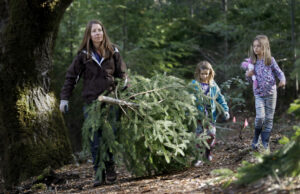
Santa Rosa-based nonprofit LandPaths hosts a “Great Charlie Brown Christmas Tree Hunt” as well as other holiday events to support its conservation mission.
The post Local Nonprofit LandPaths Offers Eco-Friendly Holiday Fun appeared first on Sonoma Magazine.
]]>






Each year on a preserve outside Healdsburg, a simple tradition — finding the perfect tree — takes on a greater purpose: protecting the forest from wildfires. Since 2017, nonprofit LandPaths has invited the public to Riddell Preserve for its annual “Great Charlie Brown Christmas Tree Hunt.” It’s a fun, eco-friendly event where visitors help thin the forest by cutting down a free holiday tree.
The scenic preserve has 400 acres of peaceful oak woodlands, majestic redwoods and rolling grasslands overlooking breathtaking Dry Creek Valley. Removing scraggly trees and invasive species reduces wildfire risk in overgrown areas made vulnerable by decades of fire suppression.
The day starts with a morning caravan up to the preserve, where drizzle often descends and dew is still visible on the forest floor. Pauline Hsu, who brought her two young children to last year’s hunt to cut down a live tree for the first time, says her family loved learning about the different species in the forest, including a massive lion’s mane mushroom they spotted.
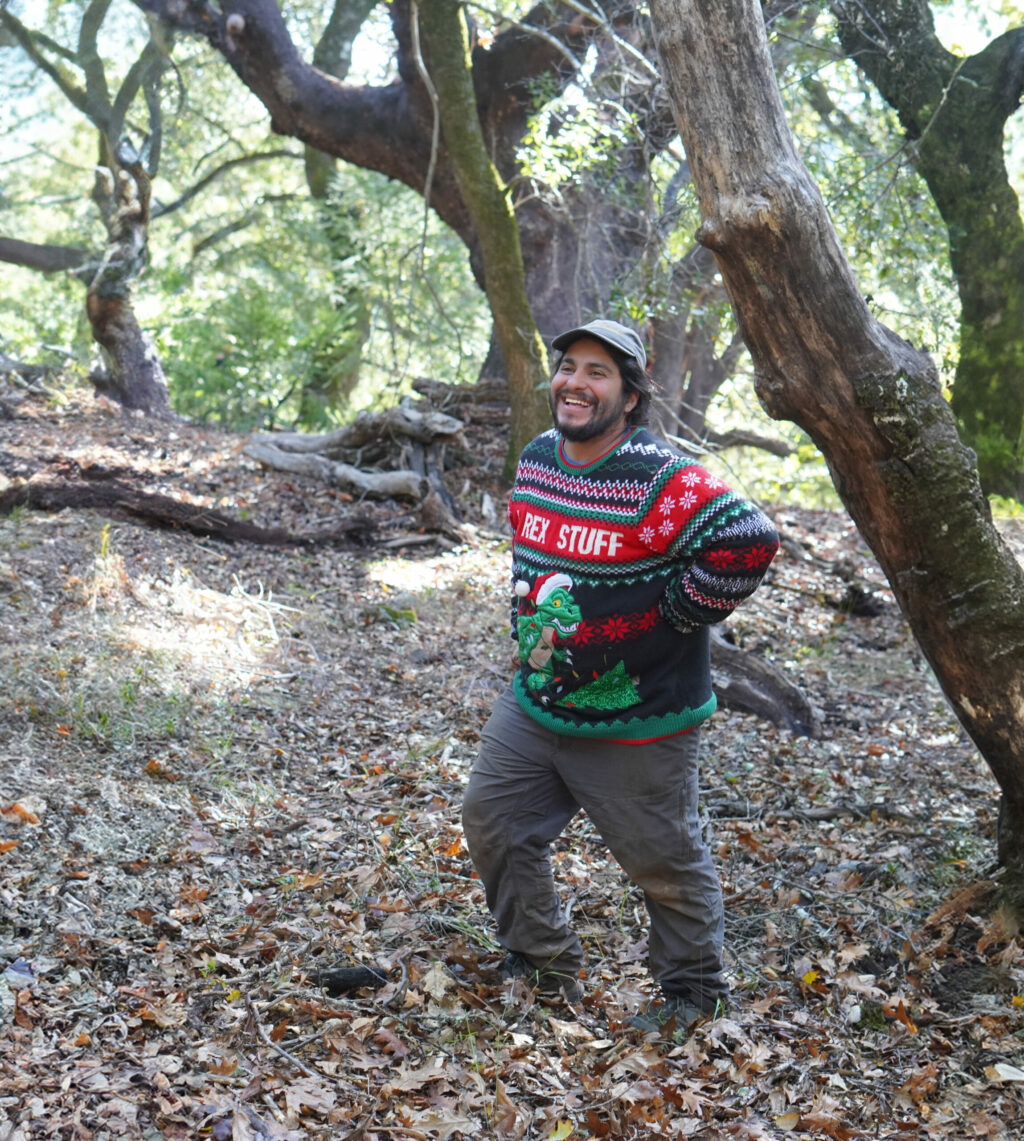
After the hunt, the LandPaths stewardship team delivers dozens of trees to the Bayer Farm and Jeff’s Garden to be distributed for free to community members. Leilani Clark, LandPaths communication director, says the day fits right in with the group’s mission to get more families outdoors. “It feels really good, and it connects people with the land,” she says.
If you missed the annual Charlie Brown Tree Hunt on Dec. 7, LandPaths will host a Charlie Brown tree give-away from 9:30 a.m. to 2:30 p.m., Dec. 14, at Bayer Farm in Santa Rosa. The event is first come, first served, and includes warm beverages as well as holiday crafting opportunities.
The nonprofit will also host a Winter Celebration from 3-6 p.m., Dec. 21, at Bayer Farm in Santa Rosa. Bring your favorite cultural dish to the celebration to win a prize. The event will include holiday music and a wreath-making station (materials and instruction provided).
The post Local Nonprofit LandPaths Offers Eco-Friendly Holiday Fun appeared first on Sonoma Magazine.
]]>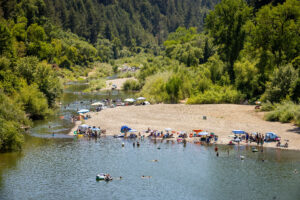
A new spirit is taking root in Forestville, though it maintains its sweet and lively west county charm.
The post ‘It’s West County Weird’: How Forestville Has Retained Its Rural, Funky Vibe appeared first on Sonoma Magazine.
]]>






Wayne Speer remembers decades ago when logging trucks would roar past his Forestville Club at all hours. Today, the lumber mill is long gone. Even his dark, windowless dive bar is a throwback to another era.
But walk down Front Street (aka Highway 116) for a block or two, and you’ll see signs of a new spirit taking root in Forestville. Maybe it’s the trippy Ricky Watts mural in front of the Record Mill vinyl shop. Or the newly opened, Asian-inspired Bazaar Sonoma next door, serving an addictively simple egg salad sandwich with yuzo mayo and crispy lotus on milk bread.
Leading the charge, Sonoma Pizza Co. opened shop across the street two years ago, building an instant following with wood-fired pizzas stacked with everything from peaches and pork cheek bacon to mushrooms and fennel sausage. Under towering redwoods and glowing paper lanterns, the shop’s back deck is a great place to savor a night out.
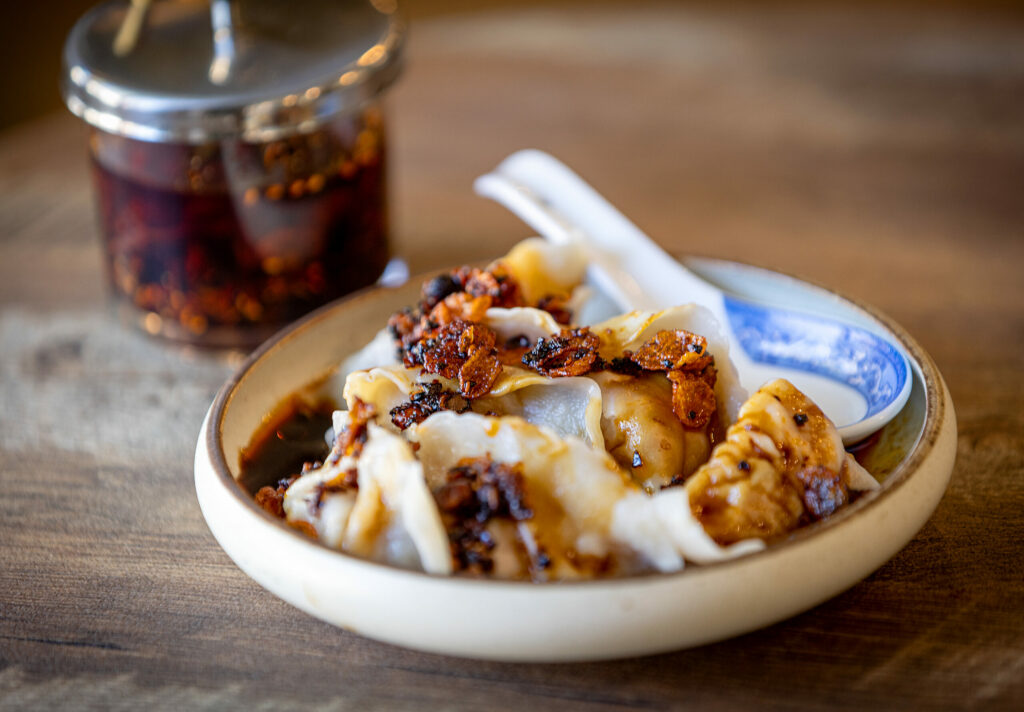

“Forestville is kind of like the last area in Sonoma County to get gentrified,” says Brian Borchers, who owns Russian River Cycle Service, which makes custom bikes and rents to riders eager to get out on the 5.5-mile West County Regional Trail. Connecting Forestville to Sebastopol and Graton, the popular route runs past farms, vineyards and cafes.
Nightingale Breads owner Jessie Frost isn’t too worried about Forestville turning bougie, she says. “It’s still funky, and sweet and lively, but it’s also weird — and I mean that as in good weird. It’s west county weird.”
You want weird? Try naming a town “Forrestville” in the 1860s, after an early settler named Andrew Jackson Forrester, and then dropping the “r” and changing it to “Forestville.” True story.
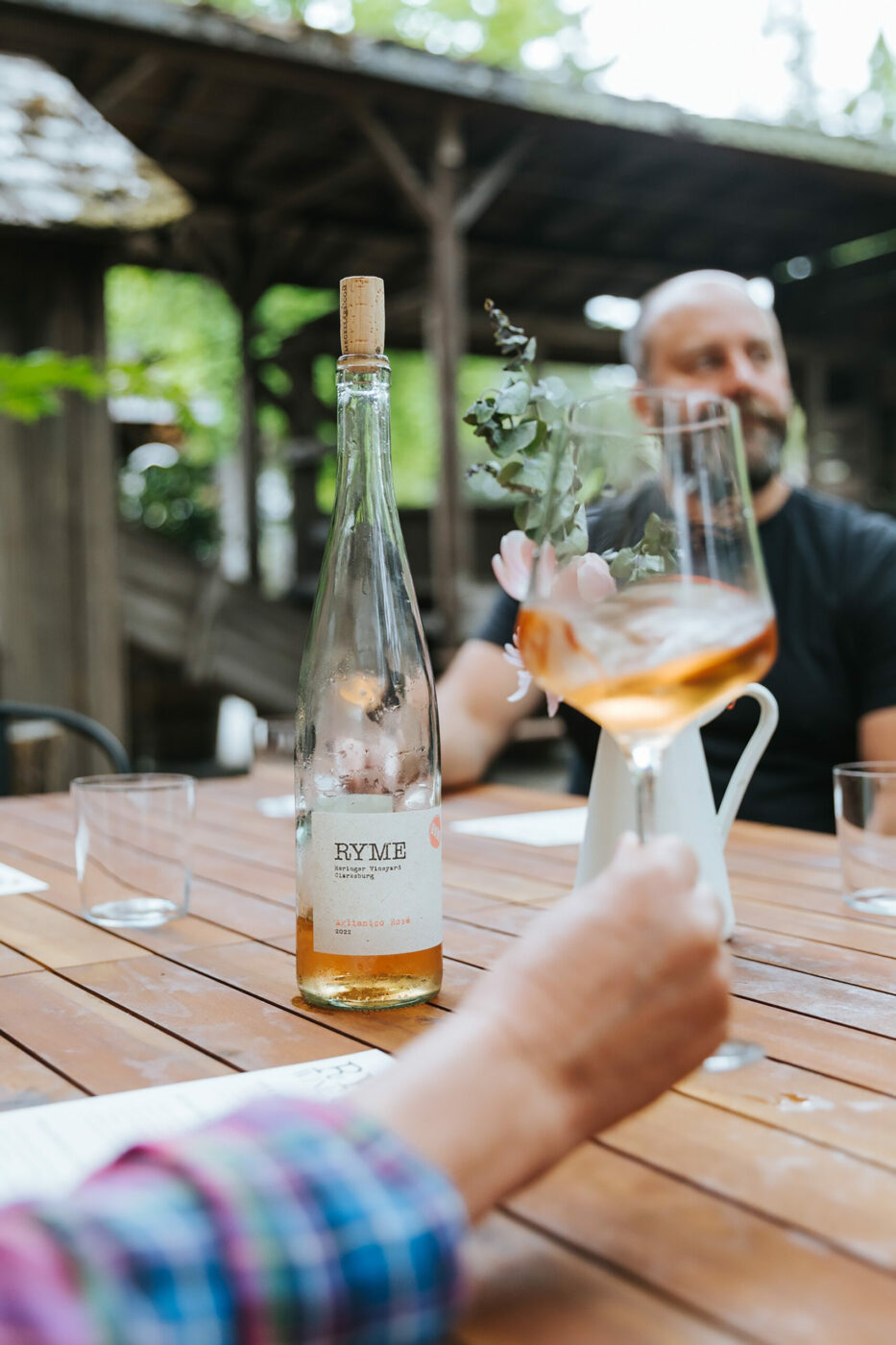
Turn right at Rick’s Auto, and you’ll wind up at Ryme Cellars, where husband-and-wife owners Ryan and Megan Glaab have a thing for Italian varieties like Vermentino, Fiano and Aglianico.
Come late fall and early winter, Forestville is one of those towns where everyone pitches in during the holidays. A guy nicknamed “Falcon Mike” hangs the Christmas lights along Front Street. Teaming up with the local chamber of commerce, Record Mill owner Chris McDonald started a new holiday town fair last year that returns on Dec. 7 with 30-40 local vendors and a roaming New Orleans brass band.
In the three years he’s owned the Record Mill, McDonald has seen nearly every walk of life coming in and out of the redwoods that surround the town. “It’s a drive-through town, but blue-collar locals are still here,” he says. “I feel like it’s one of those last west county towns that has a rural vibe that spans a full spectrum of people.”
Where to visit
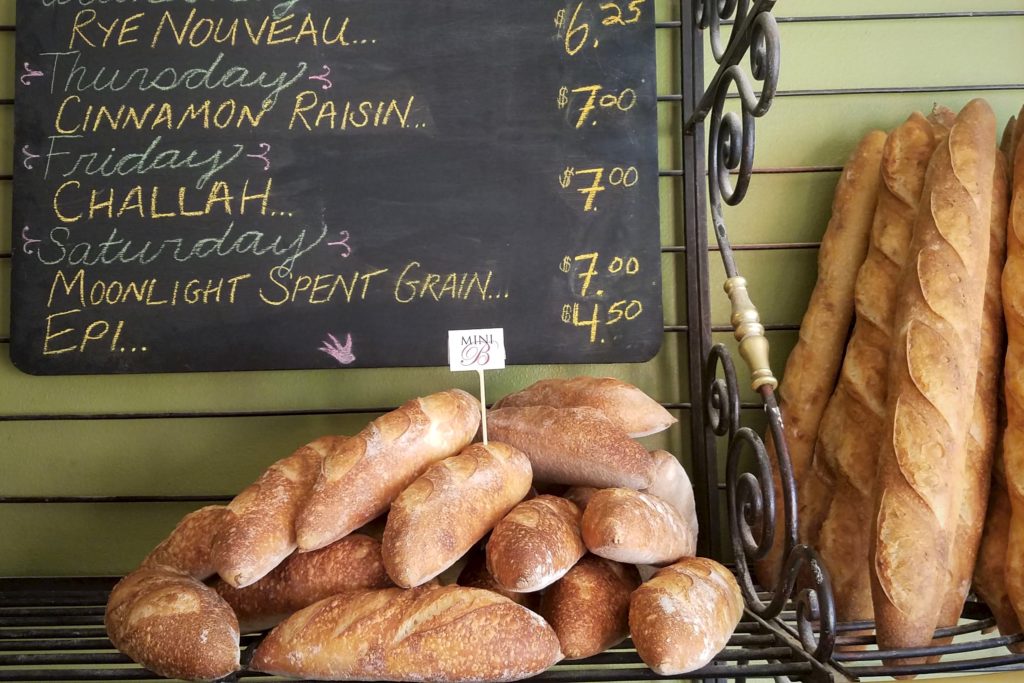
Nightingale Breads
Loyal customers would probably riot if owner Jessie Frost discontinued her best-selling sliced seeded sourdough. For the holidays, Frost makes boxed panettone and a delicious gingerbread, adding Moonlight Brewing Company’s Death and Taxes black lager to the batter. 6665 Front St., 707-887-8887, nightingalebreads.com
Sonoma Pizza Co.
Try the wood-fired Pepperoni Nirvana pie prepared Chris’s Way with hot honey and ricotta, paired with local Joseph Jewel zinfandel. Or the “Italian Stallion” sandwich — what more could you need? 6615 Front St., 707820-1031, sonomapizzaco.com
Canneti Roadhouse
Chef-proprietor Francesso Torre makes his own olive oil, focaccia and fennel salame, and his classic “Tuna of the Chianti” swaps pork shoulder for fins. 6675 Front St., 707-887-2232, cannetiroadhouse.com
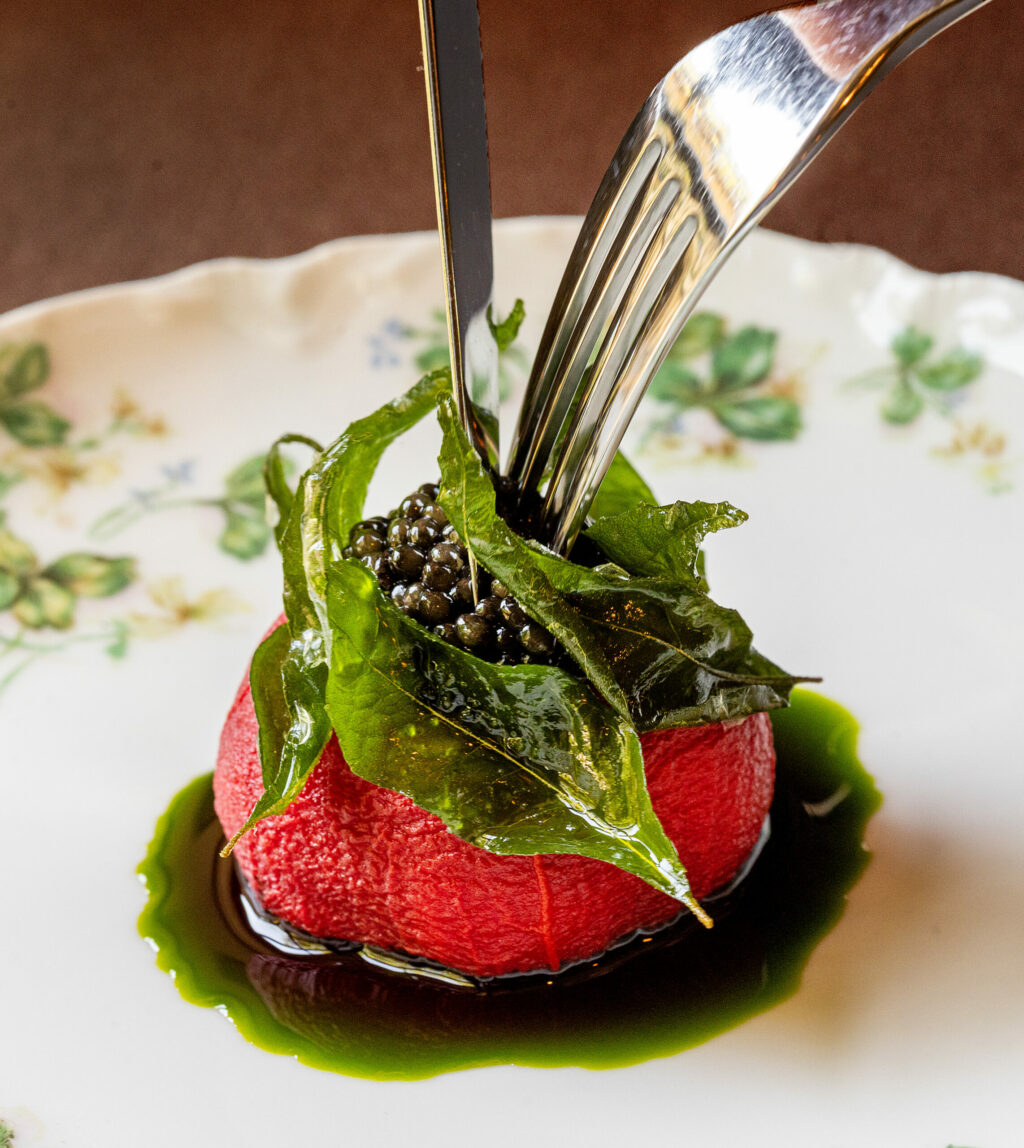
Farmhouse Inn
Last year, wine mogul Bill Foley purchased a majority stake in this exclusive luxury hotel (once bought out by Elon Musk for his birthday party) from siblings Joe and Catherine Bartolomei, who grew the 1873 vintage farmhouse into a world-class destination. 7871 River Road, 707-887-3300, farmhouseinn.com
River Bend Resort
A budget-friendly option with a giant Paul Bunyan statue out front. Where else can you spend the night in a 1970s VW Bus restored with hardwood floors? 11820 River Road, 707-887-7662, riverbendresort.net
Ryme Cellars
This Italian-leaning boutique winery hosts appointment-only tastings and super-tasty BBQ pickup parties. 6450 First St., 707820-8121, rymecellars.com
The Record Mill
Crate-digger alert: Owner Chris McDonald’s Japanese pressing of Bobby Charles’ self-titled 1976 album is a pretty good score. 6566 Front St., 707-820-7666
The post ‘It’s West County Weird’: How Forestville Has Retained Its Rural, Funky Vibe appeared first on Sonoma Magazine.
]]>